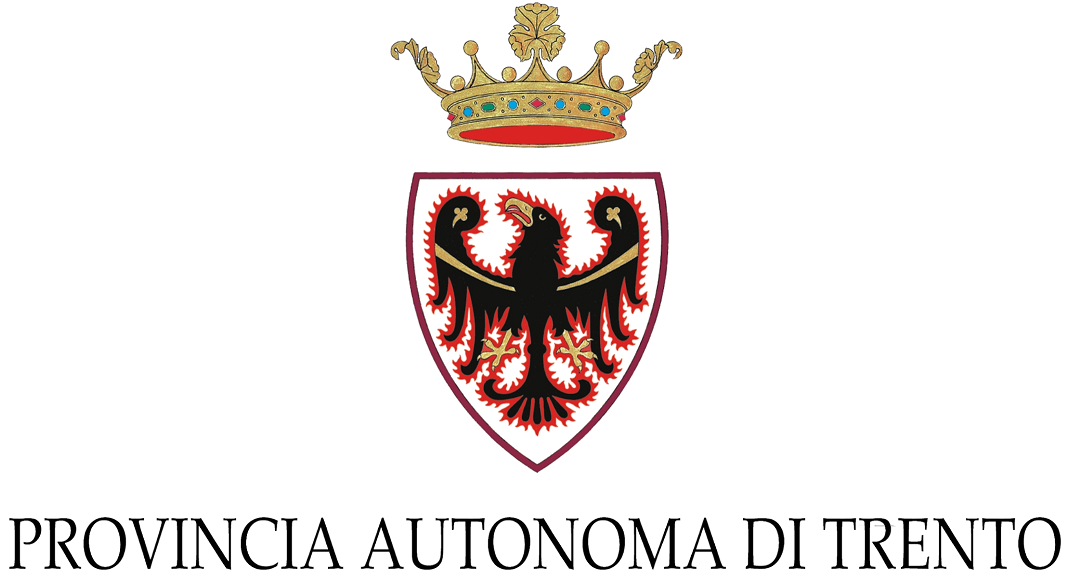The Water We Want 2024 - Drawings
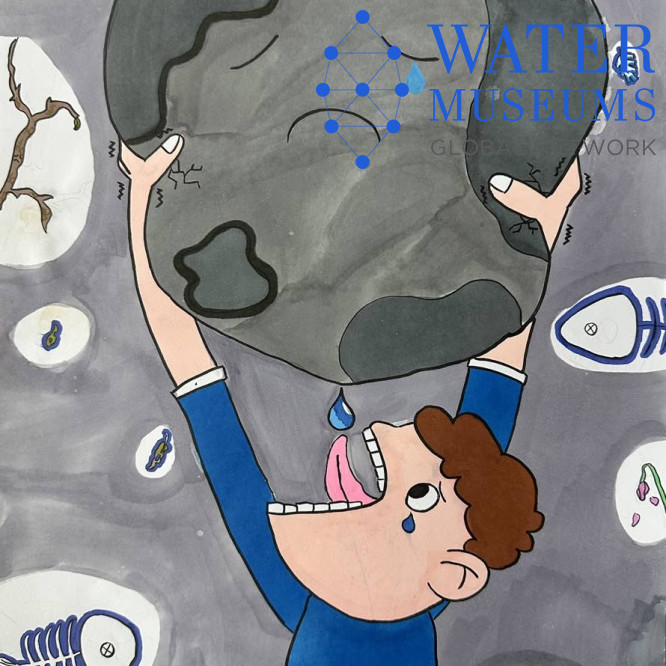
Identifier: #283

China
National Water Museum of China
The Source of Everything
National Water Museum of China, China. Zhongshan Primary School, Lishui City. Lu Yuetian
Everything has its origin. Water is very important because it is the source of life. Everything in the world can’t live without water. The proportion of water in a human body is about 70%. People can live without eating food for three days, but they will be very close to death if they don’t drink water for three days. The same goes for other creatures. What a terrible world it would be if there is no water left on the earth!
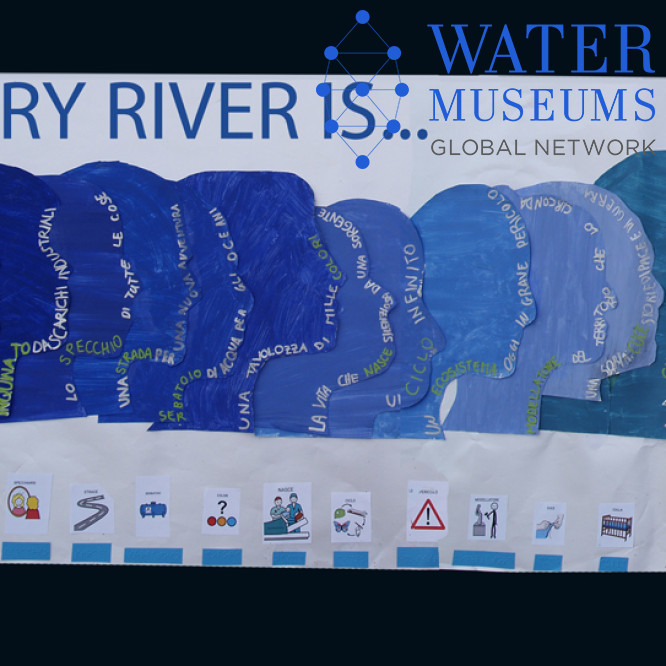
Identifier: #269

Italy
Water Museum of Venice
Every River Is…
Water Museum of Venice, Italy. Primary school “C. Gardan”, Caselle di Santa Maria di Sala. 4^A-4^B
The work represents a flowing river with its different identities and characteristics. It was created by superimposing the profiles of the students, colored in the shades of the river. For each profile, a sentence is reported, taken from Monika Vaicenavičienė's book "What is a river?". Some sentences have been chosen and transcribed in full. An aspect of the river for each child profile, united to form a single large watercourse, which embraces each of us in our uniqueness and our own way of expressing ourselves. Because EVERY RIVER IS all of this! Each sentence on the river refers to a key word, expressed inclusively also in CAA (Augmentative Alternative Communication) and Braille on labels glued under each profile.
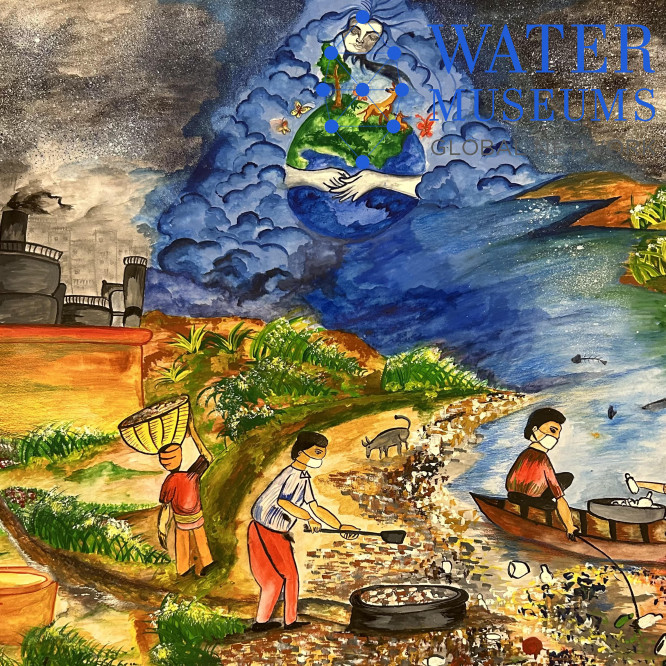
Identifier: #244

India
Living Waters Museum, India
Protect Our Surrounding Environment
Living Waters Museum, India. Bamanghata High School, Bamanghata. Sujan Sardar
Waste materials from leather factories pollute the air, water, and soil, leading to the destruction of local ecosystems and contributing to climate change. This is especially prevalent in the East Kolkata Wetlands adjacent to which is a massive leather factory. We as human beings must be more aware and act as custodians of our dear Mother Earth
Identifier: #277

China
Yellow River Museum
Protecting the Earth and Revering Life
Yellow River Museum, China. Best Bilingual Primary School, Zhengzhou. Xue Zhiqiao
Nowadays, emitted and wasted gases, dust and smog as well as increasing garbage are seriouslypolluting the environment with technology’s advancing, industries’ rising and communication’sdeveloping. It is necessary for everyone to keep environmental protection in mind and put theidea into practice. Using environment-friendly energy and resources, everyone has theresponsibility to protect the environment and care for the earth. Let's start from ourselves!
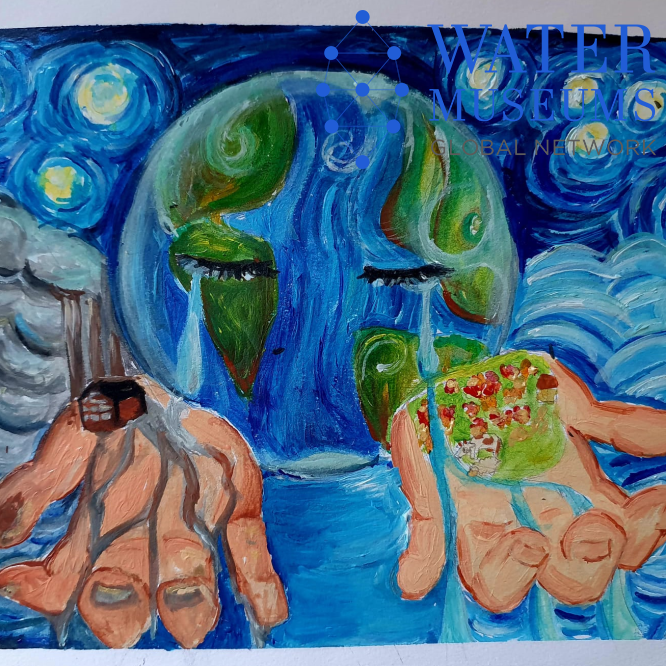
Identifier: #233

Romania
Water Museum "Leonida Truță"
Tears of the Earth
Water Museum "Leonida Truță", Romania. Școala Gimnazială Horea Cloșca și Crișan, Cluj-Napoca. Anca Sarah
Protecting it and water is essential in the context of climate change and environmental degradation. As far as water is concerned, pollution is one of the biggest problems. Anthropogenic pollution is the main contributor to the contamination of freshwater, affecting the health of the Earth as well as that of living creatures and humans. As a result, the Earth suffers because its tears are not used for good purposes. They must be used to enjoy it as it is, as God made it. They must be transformed from tears of sorrow and suffering into tears or joy and affection
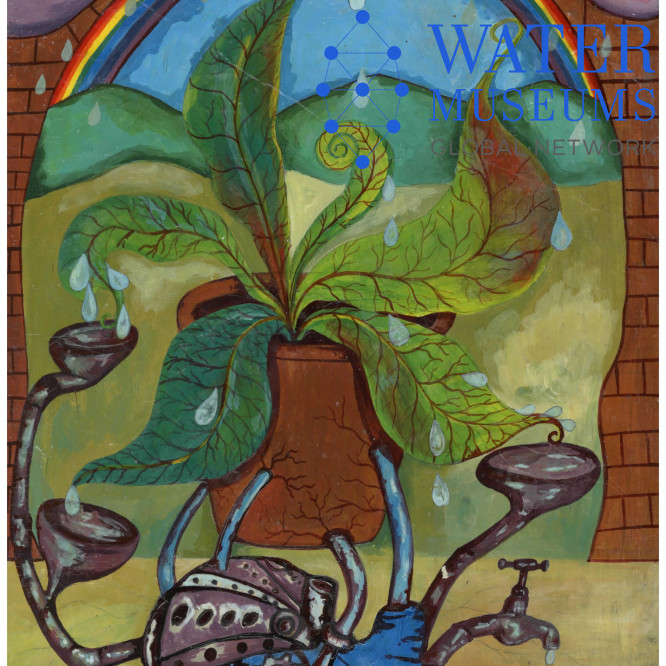
Identifier: #225

Cuba
Albear Aqueduct Museum / National Institute of Hydraulic Resources (IRNH)
There Is Rain In My Heart
Albear Aqueduct, Cuba. Escuela Primaria Jorge Soto Rosabal, Cueto, Holguín. Edier Yoan Diñeiro Aguilera
Like the functioning of the heart, but connected to nature, it should be our conscience in caring for and saving drinking water. With a cyclical scheme, this machine receives rainwater, treats it and then uses it rationally for cultivation. Here the author uses bright and cheerful colors to emphasize the water cycle and its vital importance for life. Use the technique of acrylic painting on cardboard.
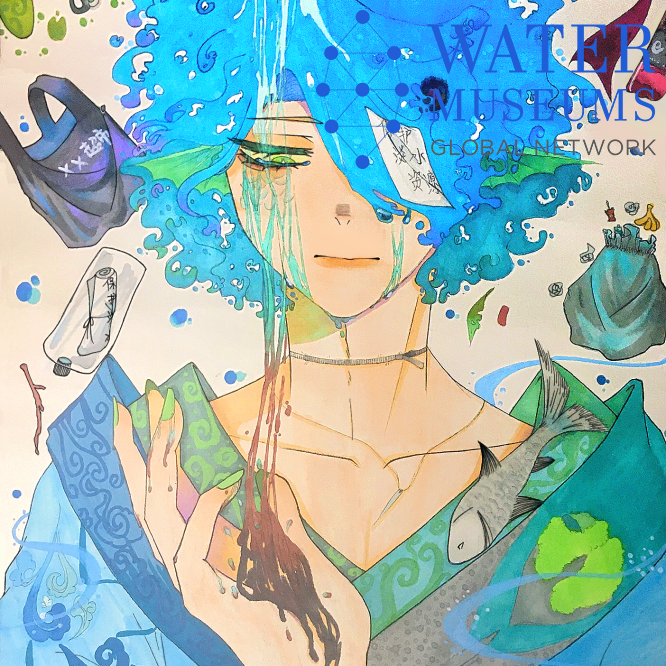
Identifier: #285
China
National Water Museum of China
Tears of the Elf
National Water Museum of China, China. The Second Vocational School in Xiaoshan, Hangzhou City. Shao Jie
Water plays an important role in our life, it is the source of life, and it is also the most important indispensable material resources for human survival and development. A person's life is inseparable from water, water is the most important material needed in life. On the Earth, where there is water, there is life. All life forms originated from water. Therefore, water, as a precious treasure endowed by nature, has long been concerned by people. Protecting water should not only be a public slogan, but also the action we must take. In the picture, the head of the elf was soaking with dirty water. Then the water came into her eyes as tears.

Identifier: #284
China
National Water Museum of China
The Water World We Want
National Water Museum of China, China. Pinghu Youth Palace, Pinghu City. Xiang Yuxuan
The student painted a beautiful earth with blue and green colors and depicted drought with the orange color. Where there’s water, there are fish, some are even jumping into the pond. Flowing water nourishes dry land. The drawing is telling us that we want water, we want a world without dry and arid land. Only water can nourish every inch of the dry land. Better earth, better life
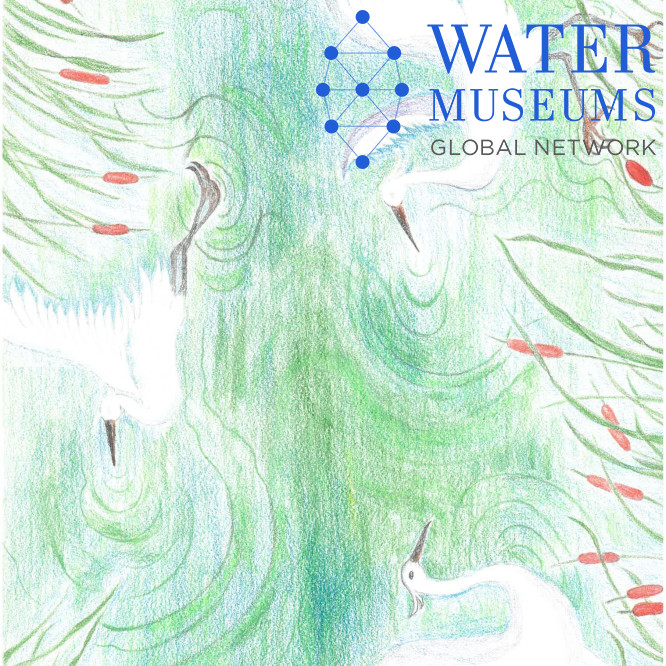
Identifier: #282
China
Canal Culture Museum
The White Egrets of Dongchang Lake
Canal Culture Museum, China. Dongguan Minzu Primary School,Liaocheng.Chen Xichang
In this picture there are three egrets playing in the lake. The lake is named Dongchang Lake. It is the biggest lake of north China. It is located in Liaocheng City of Shandong Province.Because it was polluted by the garbage and waste water,some wild waterfowl disappeared. But our government takes many efforts to protect the lake. Now the efforts do work. The water resources get better.In recent years more and more kinds of wild waterfowls appear in this lake, such as egrets,wild ducks, kingfishers. Through this work we want to appeal for everyone’s protection for fresh water and wild waterfowl in the world.
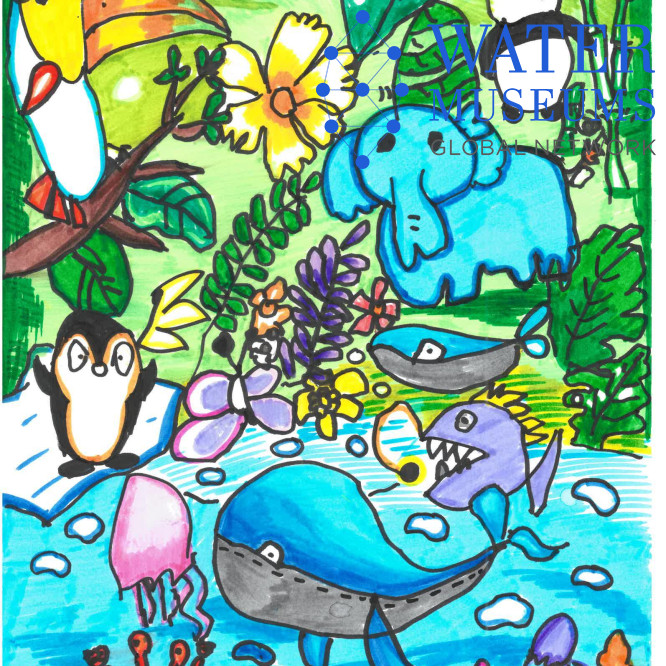
Identifier: #281
China
Canal Culture Museum
Lifeng on Earth
Canal Culture Museum,China. Jing college affiliaated experimental preschool,Liaocheng. Yin Gaoge
The little penguin in Antarctica went on a global trip and met elephants from Africa, purple monarch butterflies from Europe, giant pandas from Asia, monarch crabs from North America, and toucans from South America, and became good friends with them. The little penguin was surprised to see so many types of creatures on Earth! They have different looks, it's really interesting! Clean water allows organisms to survive, so let's work together to protect water resources and biodiversity.
Identifier: #280
China
Yellow River Museum
The Water We Long for
Yellow River Museum, China. Best Bilingual Primary School, Zhengzhou. Niu Ruichen
In this painting, animals and humans are competing for the last drop of water, which reminds us to save water. Otherwise, there is no source of life for all!
Identifier: #279
China
Yellow River Museum
Water is the Source of Life
Yellow River Museum, China. Best Bilingual Primary School, Zhengzhou. Qian Yuelin
Through this work, I want to tell everyone that water is the source of life and the foundation ofour food. Among the total water resources on the earth, only 3% is fresh water that we can liveon. So let's protect the water together!
Identifier: #278
China
Yellow River Museum
Dreaming for Clear Water and Blue Sky
Yellow River Museum, China. Huayuankou Primary School, Zhengzhou. Shao Wenxi
This painting presents the close connection between humans and fresh water as well as theurgency of protecting water resources. The painting is varied in color, with blue as dominance,symbolizing clear and pure fresh water.In this painting, center is the blue water, standing for fresh water lakes, rivers, and groundwateron the earth. Dense vegetation and energetic animals around it together create a harmonious ecosystem.
Identifier: #276
China
Yellow River Museum
The Water We Want
Yellow River Museum, China. Best Bilingual Primary School, Zhengzhou. Zhang Chenjia
Clear rivers, lakes, and ocean were once the most beautiful landscape on the earth. However,these beautiful views are gradually disappearing due to severer pollution. Protecting waterresources is to safeguard our common home, let’s make the globe beautiful and lively again.
Identifier: #275
China
Yellow River Museum
Cherishing Every Drop of Water
Yellow River Museum, China. Headstart Bilingual Primary School, Zhengzhou. Wang Li
This work depicts an exquisite water cycling system. It not only provides recycled water forpeople's daily use, but also serves as a fountain to decorate the environment. Meanwhile, itcarries active water into the park lake and waters the lawn. The work showcases multi-functions ofthe water cycling system and its positive impact on the environment, also arouses people’sthinking on the protection and rational utilization of water resources.
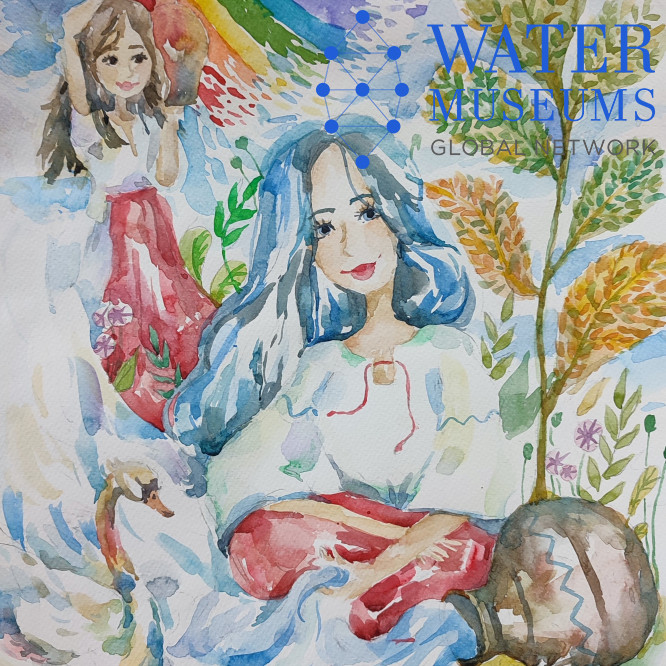
Identifier: #274
Romania
Aquapic, Timisoara
Song of Water
Aquapic, Timisoara, Moldova. Școala Raională de Arte Plastice Nicolae Moisei, Telenești, Republic of Moldova. Daniela Caprian
In a dry and thirsty world, two girls have become symbols of balance and hope. The girl in the foregroundexudes a soothing strength, her blue hair flowing like a spring of life. In her hands, she carefully pours waterinto a struggling stream, a symbol of regeneration and care for nature. Beside her, a white swan floatsgracefully, reflecting purity and harmony. In the background, the other girl lovingly brings water from afar,struggling to sustain the lives that depend on this source. Between them, a rainbow shines like a promise ofhope and prosperity. Overall, this work is an ode to humanity and nature, a call for responsibility andsolidarity in the face of environmental challenges
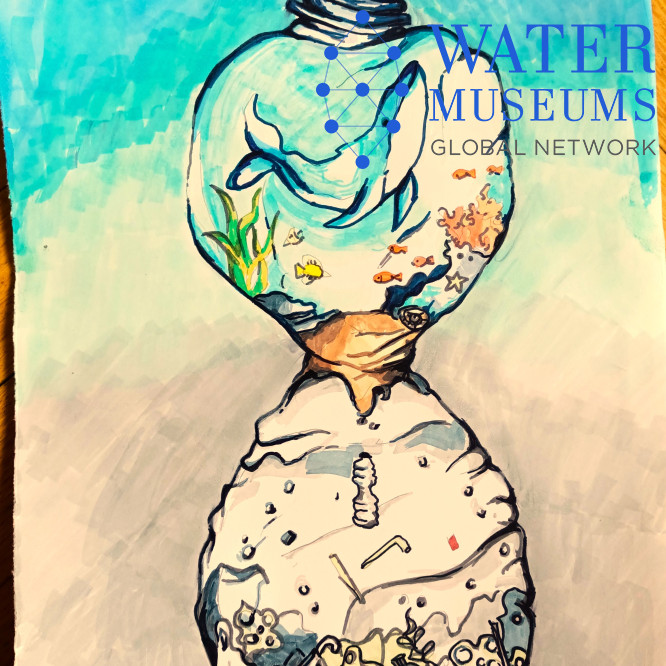
Identifier: #273
Romania
Aquapic, Timisoara
Consequence
Aquapic, Timisoara, Romania. Liceul Bilingv Miguel de Cervantes, București. Mihai Tudor Hila
Our actions, of any kind, will impact the environment and our way of living, in time. It won’t be easy to dealwith the consequences and repair the harm done. We want to have a better water and only we can make thishappen!
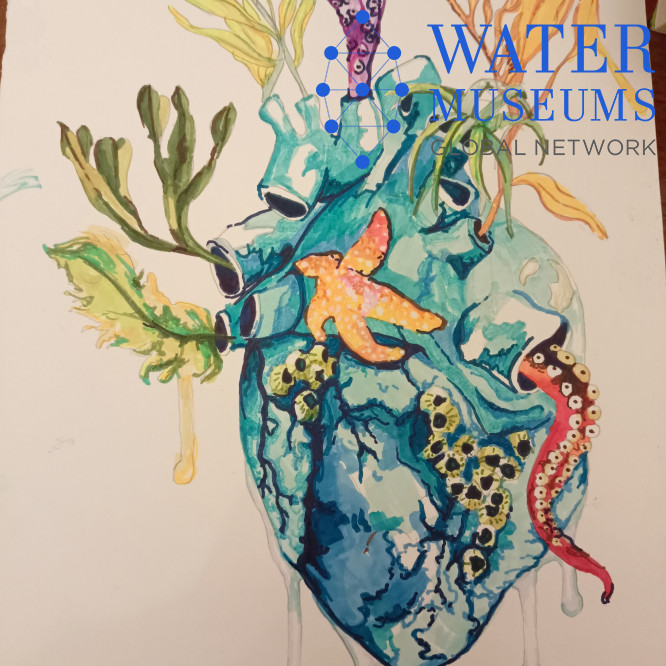
Identifier: #272
Romania
Aquapic, Timisoara
The water of life
Aquapic, Timisoara, Romania. Liceul Bilingv Miguel de Cervantes, București. Maria Ariana Hila
Through this work i wish to highlight the importance of water in our lives. if we keep the natural watersources clean, our bodies will benefit from it. let’s embrace water with love and be grateful for its presencein our lives!
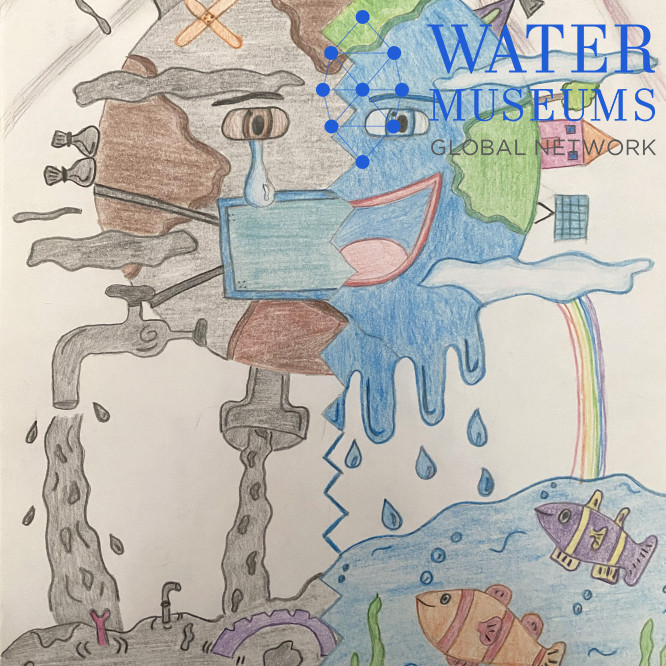
Identifier: #271
Romania
Aquapic, Timisoara
What Will the Future Look Like?
Aquapic, Timisoara, Romania. Scoala Gimnaziala, Timisoara. Carina Modra
The world that the children will inherit could be a world of disasters, a world where resources are exploited to the point of exhaustion, a world ruled by greed, but it could also be a place of cooperation, of respect for nature and life, a better and fairer place for all.
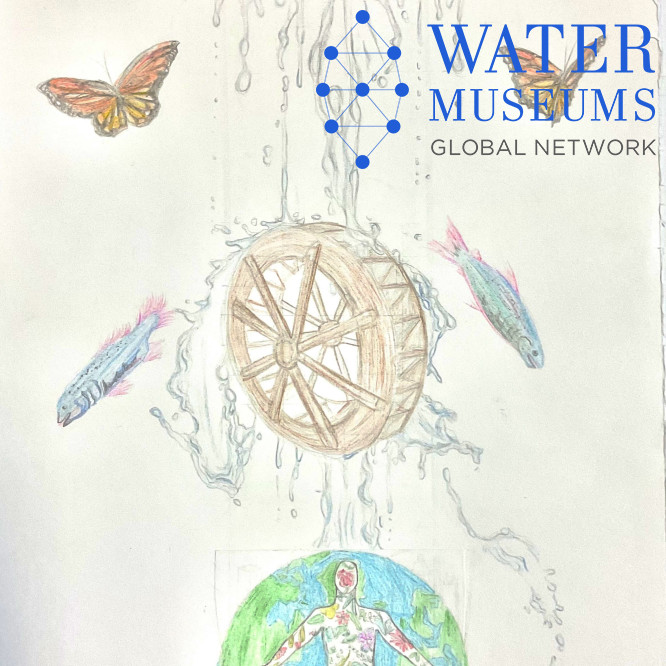
Identifier: #270
Ireland
Water Museum of Ireland
The Life Cycle
Water Museum of Ireland, Ireland. Coláiste Naomh Mhuire, Buttevant. Olivia Requejo
The planet’s life-cycle and the water-cycle are interconnected. My drawing illustrates that since thebeginning, time and water have flowed simultaneously. Hands represent mother nature spilling the water thatis necessary for Earth’s story to begin. The story is the never-ending tale of the relationship between waterand all living things. Mother nature provides the planet with plentiful supply of freshwater through rivers,lakes, streams, and ponds. We are given what we need and it’s our responsibility to respect and look after itso there is enough water for everyone, including future generations. The next stage, industrial development,is depicted by the waterwheel - perhaps the earliest source of mechanical energy. Its invention was life-changing. In an age of trying to discover zero-emission technology that provides renewable energy, the eco-friendly waterwheel has even greater significance where fish can pass through unharmed. Sustainabilitymust be our water legacy. The final section is today’s story. Water is spilling onto Earth for us to use butdrought is also represented by the dry, cracked ground. The little sapling which grows from the stray splashof water denotes hope, that if we reverse effects of climate change, Earth’s diverse biomes can survive andflourish.
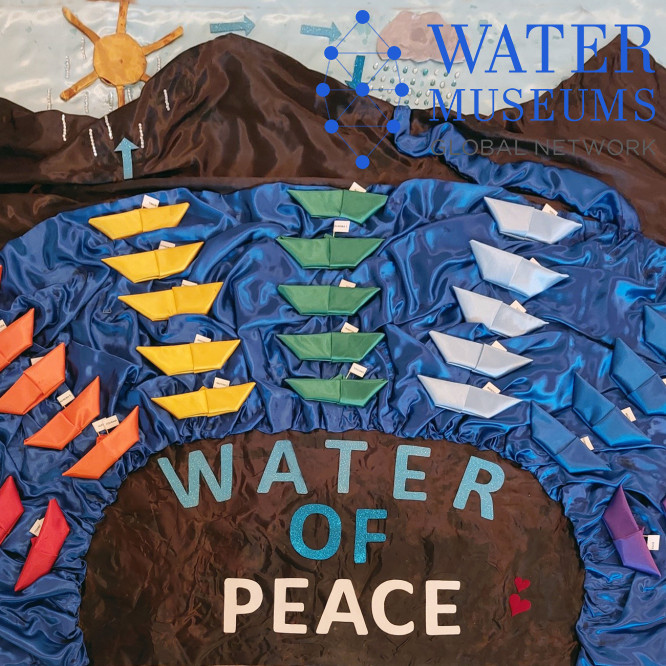
Identifier: #268
Italy
Water Museum of Venice
Water Of Peace
Water Museum of Venice, Italy. “G. Leopardi” Primary school, Campagna Lupia. 4^A - 4^B
We travelled with the fresh water of the river, following it from the source to the mouth. Then, when it started to evaporate, we saw the clouds flying in the sky. In the form of rain, when it was time to return, the sound of water drops on the earth made us dance. Water is a universal good: it must be loved, preserved and protected. We boys and girls let ourselves be carried by the water and we want to continue our journey. But there is no life if there is war in the world so, in the water of a great river, let’s go sailing and with the colors of the rainbow the beautiful planet we try to save. It will be a blue and colorful message of peace that to humanity, happy and together, we want to give. Water in the past: you are the source life gave us. Water in the present: you quench every living being’s thirst. Water in the future: power of nature… you will remain a source of pure energy. Fresh water of hope: flow in abundance for us in the world. Clean water of PEACE: wash the Earth’s wounds and erase wars everywhere!
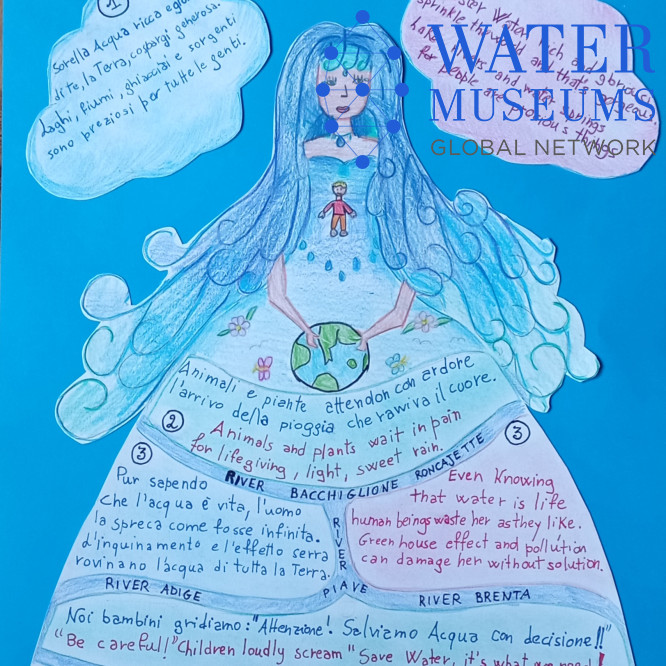
Identifier: #267
Italy
Water Museum of Venice
Sister Water
Water Museum of Venice, Italy. "P.R.Giuliani” Primary school, Ponte. San Nicolò 3^A
The Water Manifesto entitled "Sister Water" illustrates and personifies the local water with its main rivers. The Manifesto expresses, in rhyme, five points of reflection and in-depth analysis proposed to pupils at school: the importance of the sweet water - human beings and water - pollution alert - children's plea - the commitment to respect the water.
Identifier: #266
Italy
Water Museum of Venice
The Life Along The River
Water Museum of Venice, Italy. "A. Martini” Secondary school, Peseggia di Scorzè. Ester Miglioranza class
What would life be like for humans and entire planet without water?
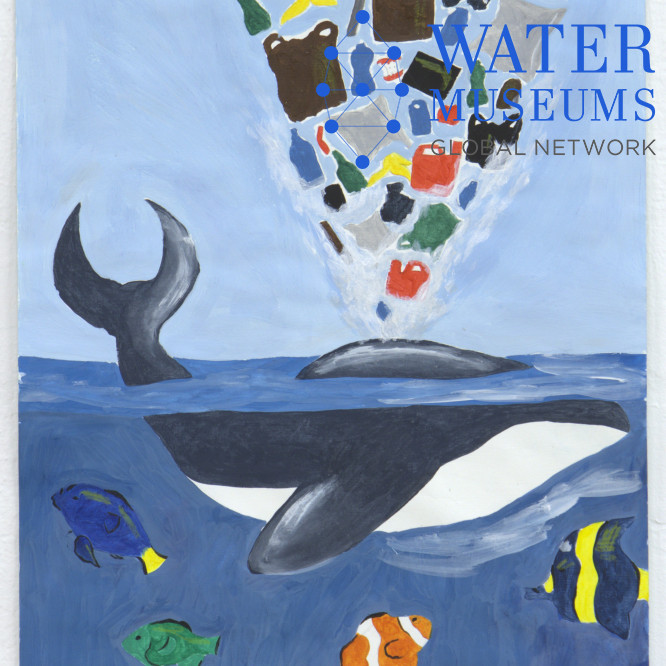
Identifier: #265
Slovenia
Posavje Museum Brežice
Polluted Sea
Posavje Museum Brežice, Slovenia. Marjana Nemca Radeče primary school, Radece. Neza Klansek
I drew a picture on the subject of pollution, where a lot of waste passes through the whale body, which we as humans throw in nature
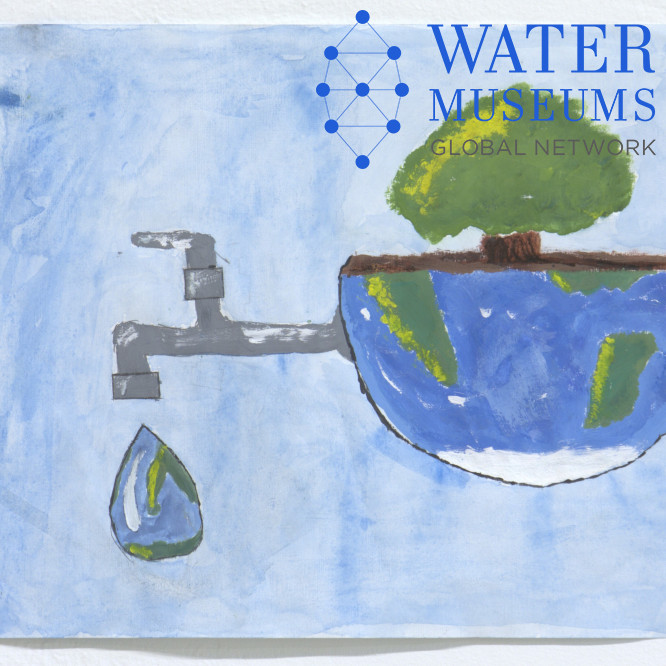
Identifier: #264
Slovenia
Posavje Museum Brežice
Save The Water- Save The Trees
Posavje Museum Brežice, Slovenia. Marjana Nemca Radeče primary school, Radece. Inja Dragar
I just wanted to tell people that we are losing our planet Earth because we are destroying it. We are going to lose bees, trees and water. This is what I was thinking about
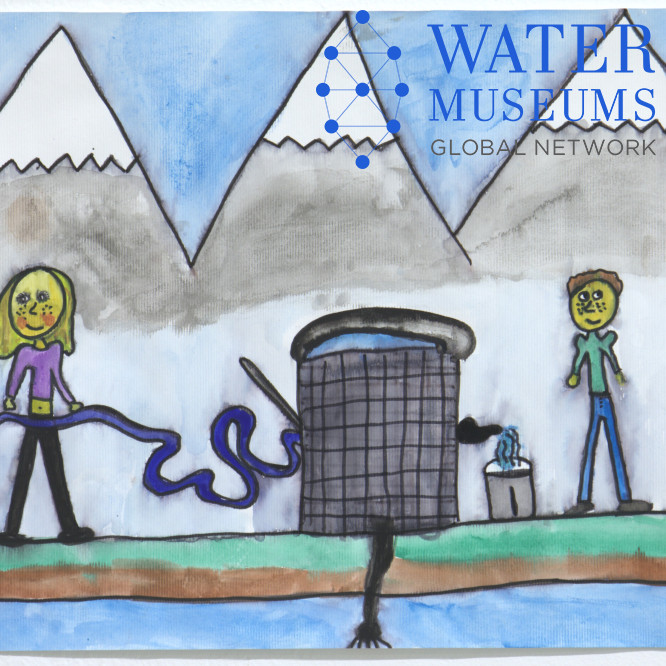
Identifier: #263
Slovenia
Posavje Museum Brežice
In The Company Of The Well
Posavje Museum Brežice, Slovenia. Primary School Brežice, Brežice. Alja Vornik
Two children draw water from the well, each in their own way
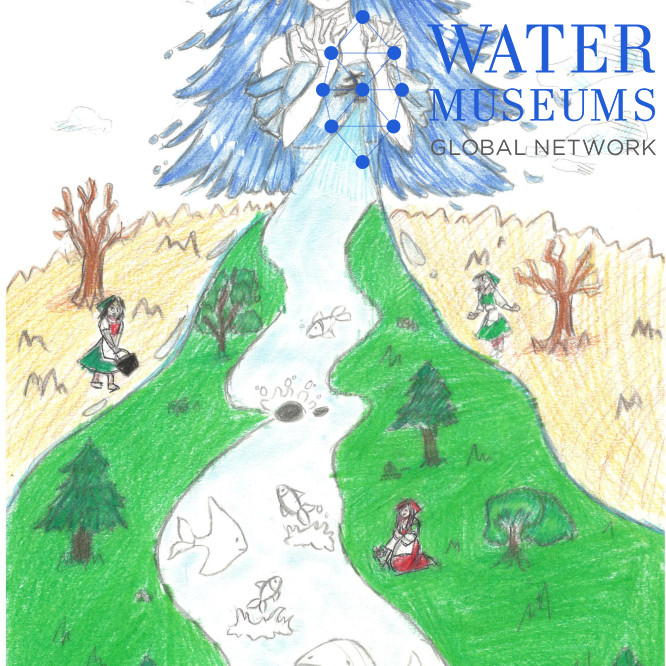
Identifier: #262
Romania
House of Water Museum
Mother Water
House of Water Museum, Romania. Valea Largă Secondary School. 4th grade
One day, Mother Water remembered her children in the arid lands. Knowing that without water they were in danger of death, she opened wide the door of her heart and poured forth streams full of life. As the water spread over the land everything came back to life. Nature burst with colour and all earthly and aquatic beings were full of joy. They marvelled at the power of Mother Water and expressed their gratitude. Everything around is green, people were shouting for joy, the grass regained it's colour and the flowers regained their beauty
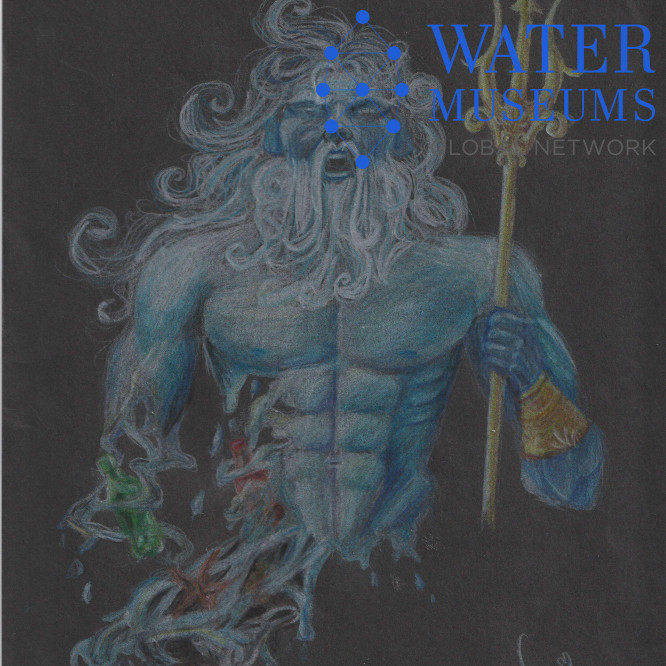
Identifier: #261
Romania
House of Water Museum
Old River
House of Water Museum, Romania. Colegiul Național Pedagogic „Mihai Eminescu", Târgu Mureș. Crisan Nicoleta
In an old folk legend, it is said that in the past, at the end of autumn, rivers turned into elders, gathered in the middle of forests and talked about the beauties they saw. Then, clean and quiet, they froze their banks, and waited for a new spring to travel again. For a very long time old rivers no longer talk about beauty, tranquillity and cleanliness. They live in the darkness of pollution, and their bodies begin to decompose due to the weights they carry on their way- waste. Together we can give life back to the Old River!
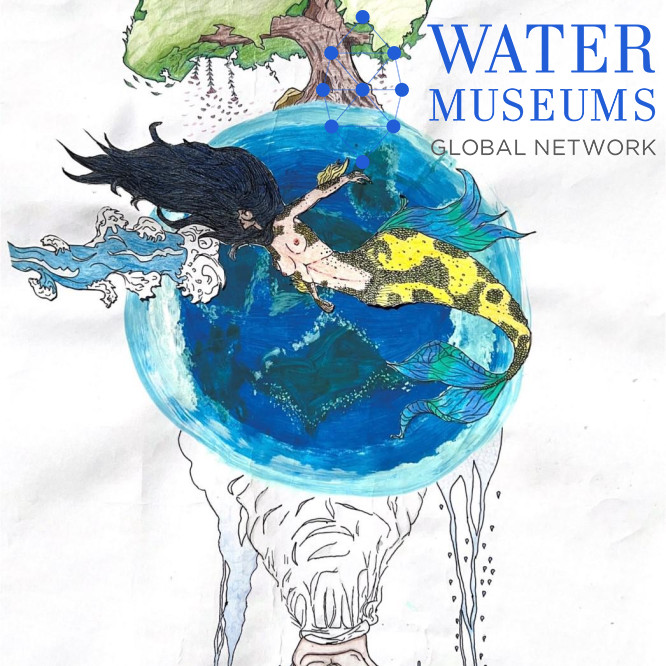
Identifier: #260
brazil
Brazilian Water Museum
The Fresh Of Fresh Water
Brazilian Water Museum, Brasil. Escola gradual girassol de tempo integral Meira Matos, Aparecida de Rio Negro. Wesley Kelvy Andrade da Silva
In a world where fresh water is an essential treasure for life. In this scenario we cannot ignore the crucial role of trees, being like silent sentinels, witnesses of the passage of time and guardians of the earth. As we face challenges such as pollution and water scarcity, we must remember the importance of preserving and honouring these guardians of fresh water. Because only through respect and cooperation with nature can we guarantee a prosperous future for all beings who share this beautiful planet
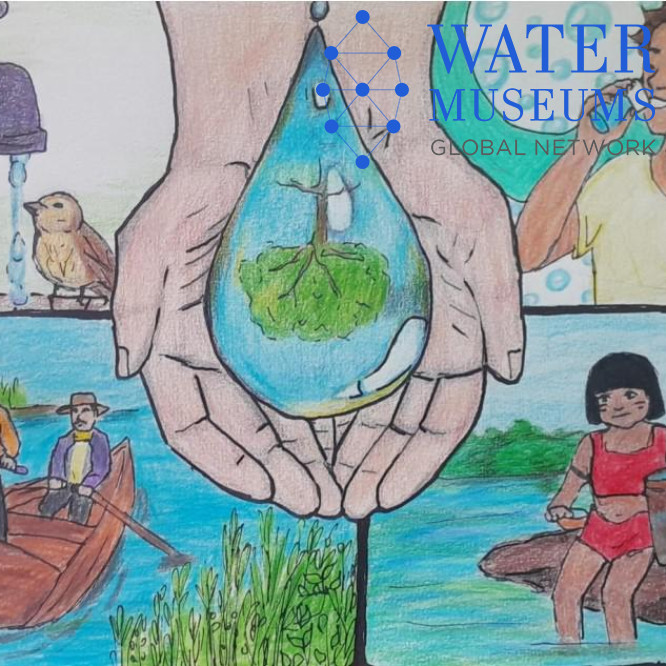
Identifier: #259
Brazil
Brazilian Water Museum
Water: A Precious Liquid In Our Hands
Brazilian Water Museum, Brasil. Escola municipal rozenda zane Moraes, Montes Claros. Sarah Oliveira Silva
The drawing shows the importance of the water for tribes and communities that use the water to water their crops, in fishing, as a means of transport through boats and canoes. Therefore how human beings depend on it
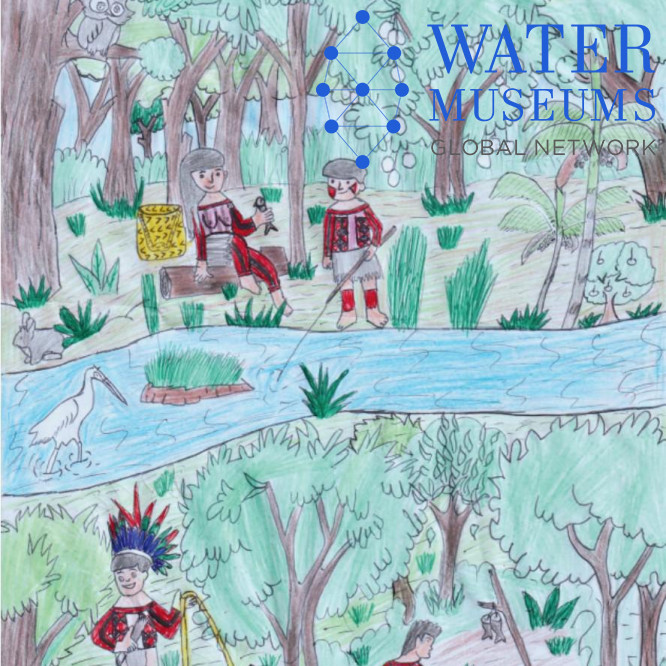
Identifier: #258
Brazil
Brazilian Water Museum
Interconnection Between The Apinajé Indigenous Community And The Tocantins River
Brazilian Water Museum, Brasil. EscoIa Indígena Tekator, .Paula Tamkakre Ribeiro Apinaje
The drawing depicts the interconnection between the Apinajé indigenous community and the Tocantins River and its streams present in their lands in the indigenous territory. Traditional indigenous paintings adorn the scene, symbolizing the spiritual and cultural connection of the Apinajé people with water and nature. Streams represent not only vital sources of water, but they are also symbols of life, sustenance, leisure and fun and their essential natural ecosystems for the Apinajé indigenous community, with beautiful crystal clear and icy waters that delight to look at, and with the songs of birds, which brings peace and pure air of nature. This Theme describes water as a source of life to the Apinajé indigenous people.
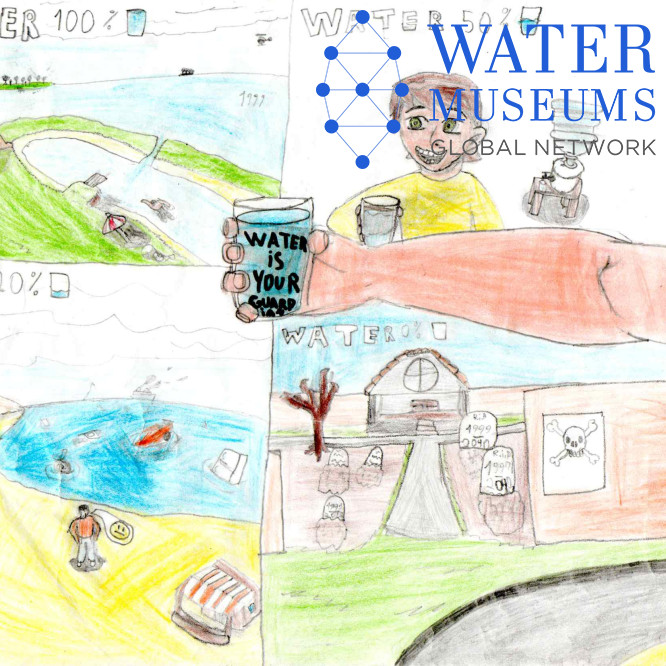
Identifier: #257
Brazil
Brazilian Water Museum
The Water Is Life
Brazilian Water Museum, Brasil. Escola estadual Ana Macedo Maia, Porto Nacional. Lucas fidelis dos santos
The draw shows a hand holding a glass of water in the center, highlighting the importance of water for it. Around the hand, first of all there are people taking a shower and playing in the water that was 100% pure. Then a person drinking water, showing that the water was already 50% unfit for use. Later, a person observed the water pollution. And finally, we have a cemetery that shows that it is not possible to exist without water. Therefore, the drawing portrays the process that is leadng the imminence of lack of water for humanity in the future
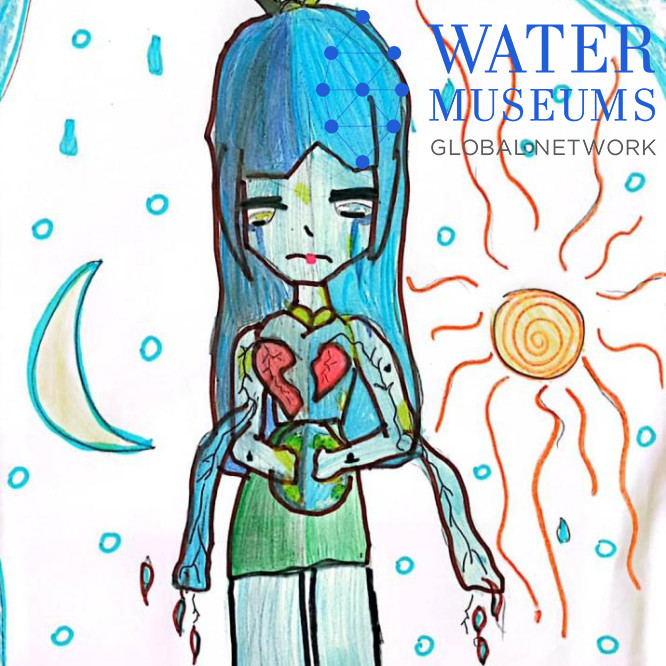
Identifier: #256
Brazil
Brazilian Water Museum
Water Is The Vein Of The Earth
Brazilian Water Museum, Brasil. Tarquinio Cobra Olyntho, Sao Jose de Rio Pardo. Alice Sophie
My drawing was inspired by my veins, how it guides the blood through my body the water and the vein that give us life to our world. Water is the vein of the earth
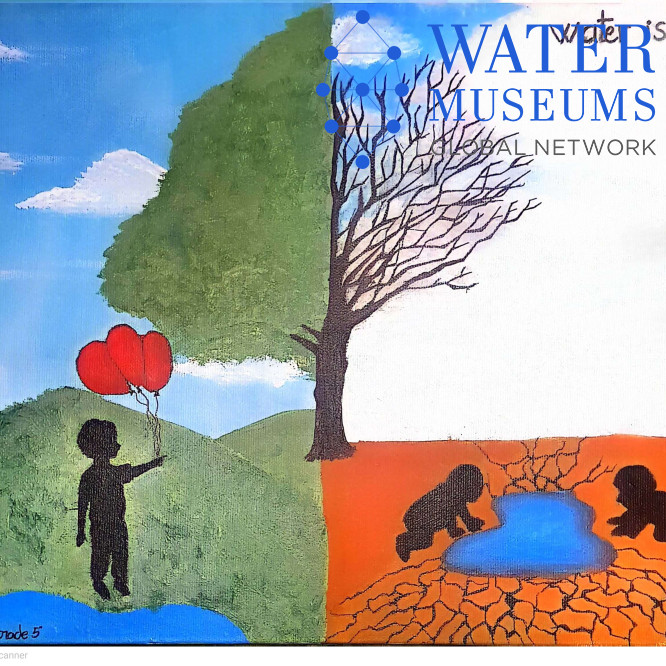
Identifier: #255
Morocco
Musée Mohammed VI - Aman, Marrakech
Water Is Life
Musée Mohammed VI - Aman, Morocco. Hilali Terga International School, Marrakech. Ranya el ouarz
I drew this drawing because water is important for our life. There are some people who don't even have water to drink. If there is no rain there will be no life. So, we mustn't waste a lot of water if we want people to have enough water to drink in the future
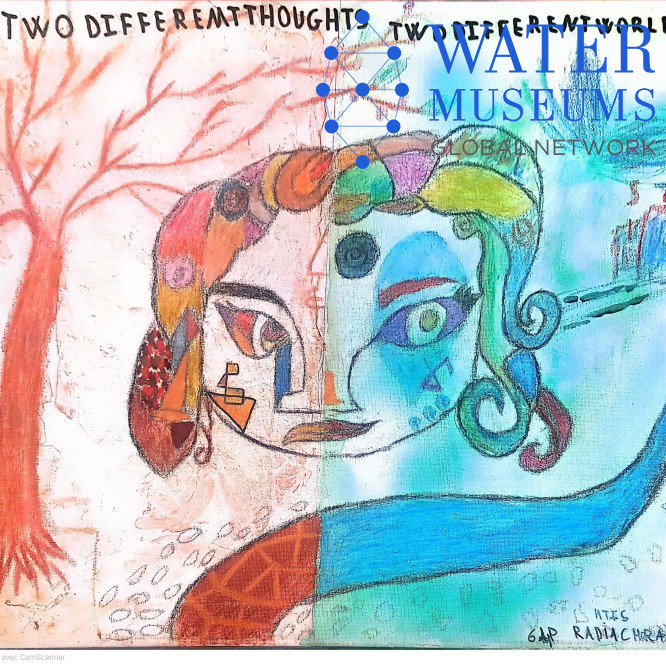
Identifier: #254
Morocco
Musée Mohammed VI - Aman, Marrakech
Two Different Thoughts Two Different Worlds
Musée Mohammed VI - Aman, Morocco. Hilali Terga International School, Marrakech. Radia Chraibi
My painting is a calligraphic painting representing two different faces, a happy face and a sad face of a world that preserves water and takes care of nature and the sad face is a city which has not taken care of water and which does not know how to find water. That's why it suffers from a terrible water shortage we have to take care of water in the manner of happy face
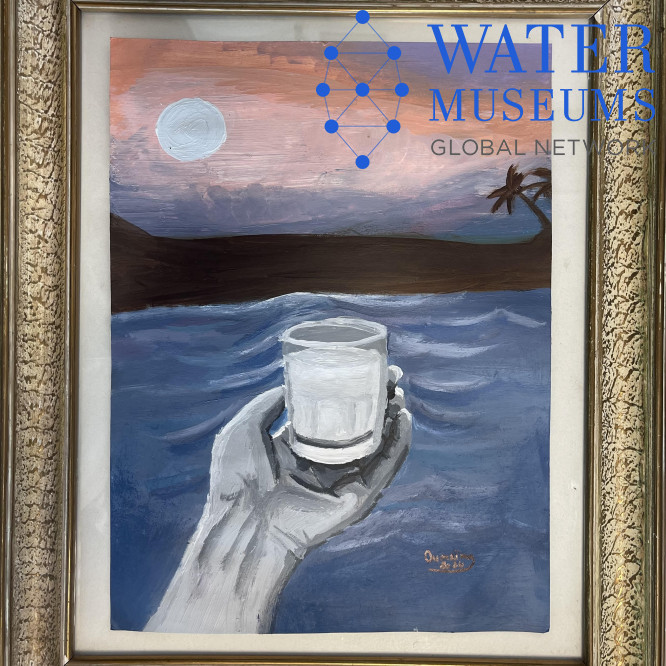
Identifier: #253
Morocco
Musée Mohammed VI - Aman, Marrakech
The Cup
Musée Mohammed VI - Aman, Morocco. Arganier High School Izdihar, Marrakech. Oumayma Janah
Nothing compares to you, a descender from the sky like pure water, from you i have nothing but this cup healing my sorrow whenever echoes assail me returning what was lost to me
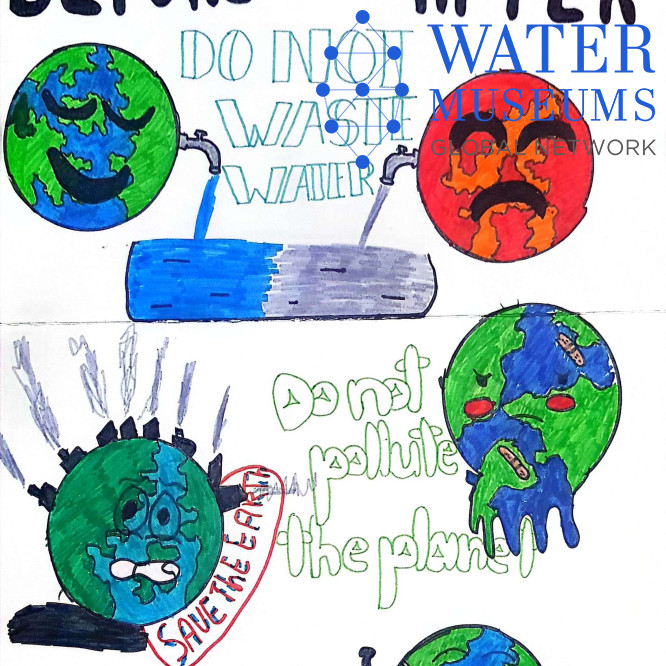
Identifier: #252
Morocco
Musée Mohammed VI - Aman, Marrakech
The Water We Want
Musée Mohammed VI - Aman, Morocco. Hilali Torga International School, Marrakech. Kenza Oulaad
The earth is the most important thing in our life, some have to protect it. There are different ways to do that. My illustration talks about the earth and the water, we have to protect them and don't waste the water

Identifier: #251
Portugal
Lisbon Water Museum
Inside Our Home
Lisbon Water Museum, Portugal. Academia de Música de Costa Cabral, Porto. Alice Pinto, Leonor Monteiro, Margarida Aires
Our home is dying... on the surface, it may seem like everything is fine, but the Earth's freshwater resources are being destroyed by humans. Every day, tons of waste contaminate our water reserves and polluting gases are emitted. Therefore, with this collage, we intend to raise awareness of the issue of water resource pollution and the impact it has on our planet before it is too late.
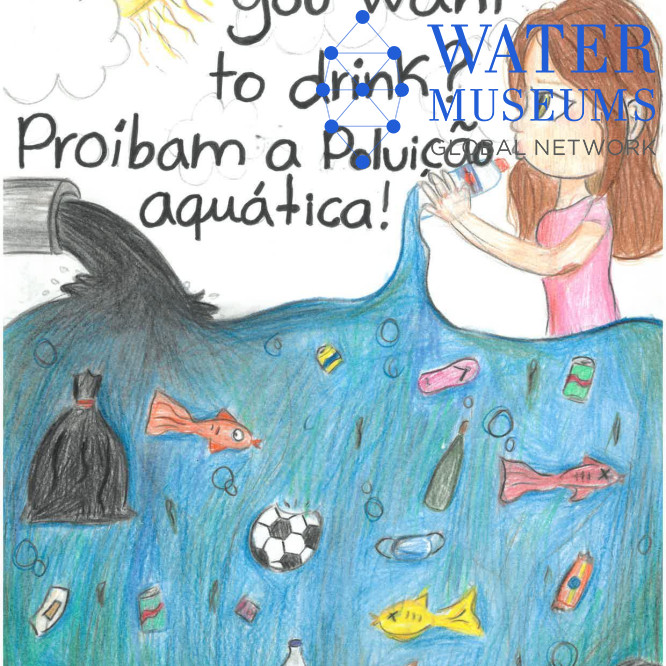
Identifier: #250
Portugal
Lisbon Water Museum
Stop Water Pollution
Lisbon Water Museum, Portugal. Escola Básica 2,3 Vírginia Moura, Guimarães. Sérgio Mendes da Costa
Water is essential for both humanity and biodiversity. Despite their extreme importance, water resources have suffered degradation processes and almost half of the areas covered by fresh water are compromised. The graphic elements of this design show the results of inappropriate use by the human population and the impacts caused by industrialization. This drawing aims to raise awareness for the conservation of this resource, it’s for young people who live in places where water is scarce, and also for those who live with some abundance but who deliberate waste it.
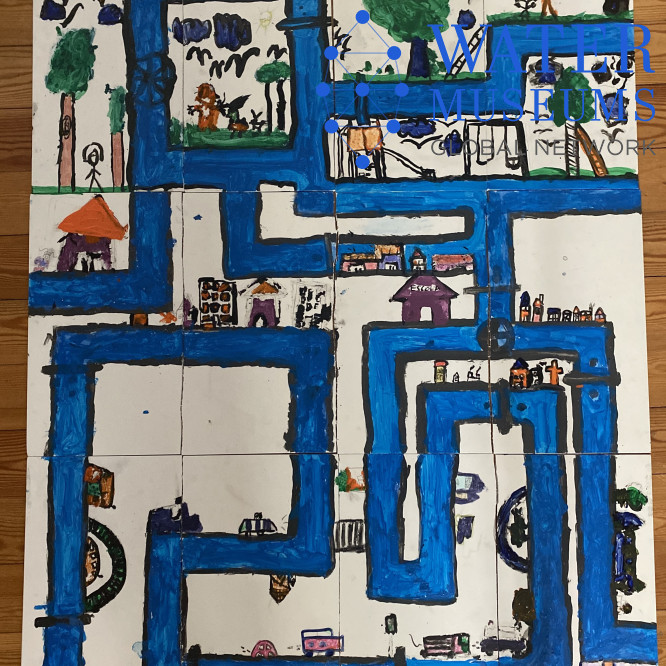
Identifier: #249
Portugal
Lisbon Water Museum
Fresh Water Puzzle
Lisbon Water Museum, Portugal. Escola Básica Luísa Ducla Soares, Lisbon. 3rd grade class (21 students)
Water is one of the most precious assets on our planet and without it we cannot survive. Did you know that only 3% of the water in the world is fresh water? For this reason, we must adopt measures to save this very important resource, as it could easily run out. At Escola Luísa Ducla Soares we do our part. Because good habits begin at a young age, we have environmentally friendly taps and toilets. So that we can help you come up with more ideas on how to save drinking water, the third-year class decided to create a puzzle on this topic so that everyone can learn in a fun way. We hope you enjoy and learn with us!
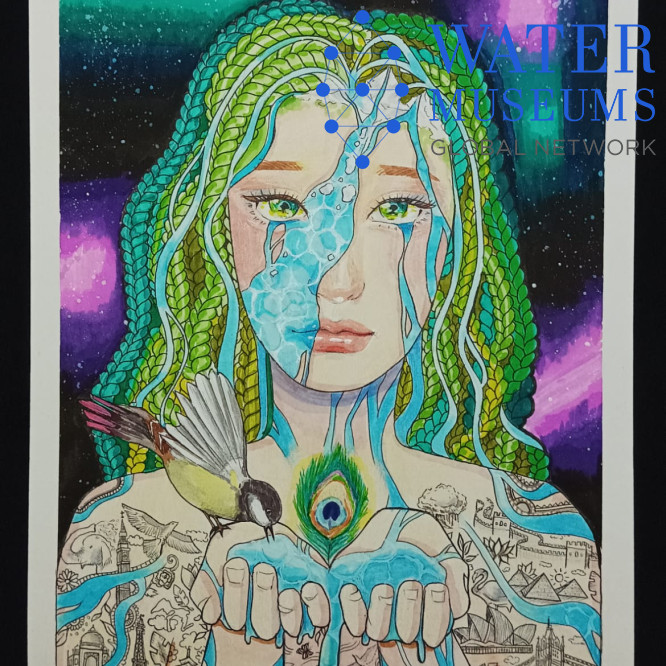
Identifier: #248
India
Living Waters Museum, India
Sweet Waters
Living Waters Museum, India. Bidya Bharati Girls High School, Kolkata. Aheli Banerjee
Water water everywhere, not a drop to drink”..Water, so purposefully depicted in the above lines of the poem, is probably the most precious thing in the world. The earth is the only planet to have water on it. Water plays the main role behind life as it is the main constituent of any cell, whether it is plant or animal. The earth is covered with 70% of water but only 1% of it is sweet water, i.e. the water is fit for drinking. Common sources of sweet water are glaciers, rivers, streams, lakes, ponds and rainwater. Actually, the earth’s content of sweet water gets refilled through the water cycle. Deforestation, pollution and global warming are causing the content of sweet water on the earth’s surface to decrease day by day. But without it there would have been no life because the relation between humans and the earth is indescribable as one depends on the life of the other for the survival of itself. So, through this painting, I, Aheli Banerjee, want to convey to the society to maintain the ecological balance in both urban and rural areas for not only the survival of us, but also for the earth.
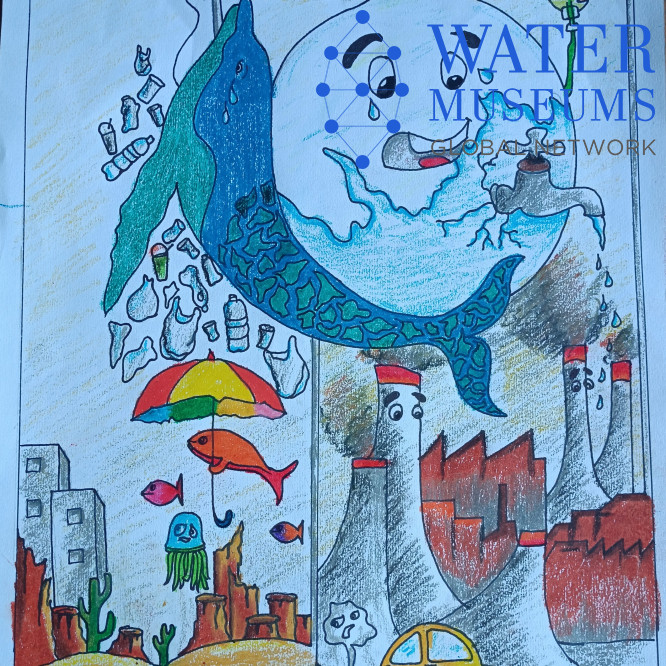
Identifier: #247
India
Living Waters Museum, India
Confluence In Crisis
Living Waters Museum, India. Mahadevi Birla World Academy, Kolkata. Sridatri Dasgupta
Navigating Water Scarcity, Climate Change and Biodiversity Loss. Because of unethical deforestation, emission of greenhouse gases from factories and fossil fuel-driven vehicles causing global warming that put the human race towards extinction from a dire shortage of drinking water. The use of plastics has made things worse because of the fatal effects on marine life. It's time, if not late, we should plant more trees to have rain immediately. Otherwise, we have to be prepared to see taps running dry. Education to build a more sustainable and resilient future for both people and the planet.
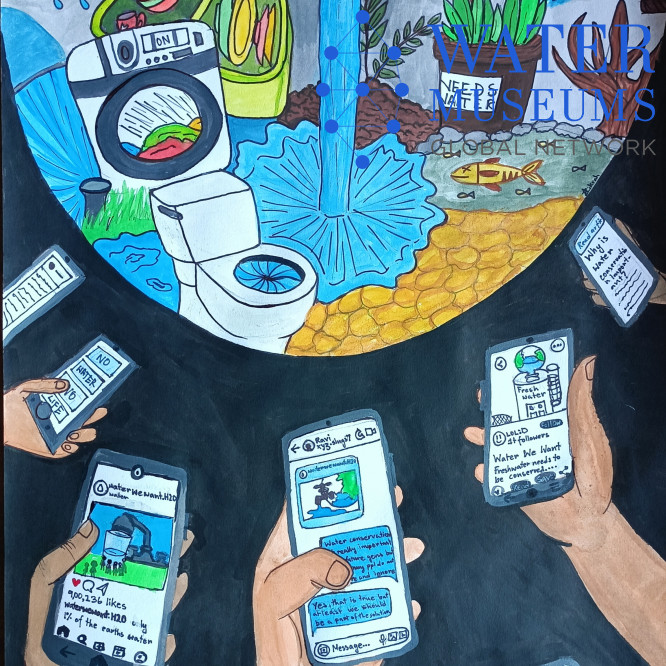
Identifier: #246
India
Living Waters Museum, India
Water Awareness
Living Waters Museum, India. Mahadevi Birla World Academy, Kolkata. Zikrah Afaque
The artwork visually depicts the various applications of water in our daily lives, including drinking, cooking, cleaning, and gardening. It also emphasizes the importance of raising awareness about water conservation, enabling individuals to understand their water consumption and identify opportunities for reduction. The painting serves as a poignant reminder of our collective responsibility to practice mindfulness in water usage and actively implement water conservation measures.
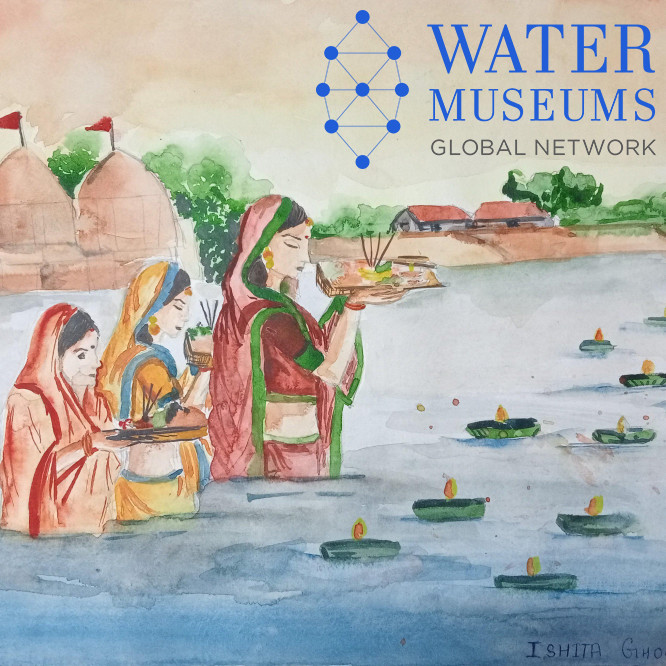
Identifier: #245
India
Living Waters Museum, India
River, Women And Faith
Living Waters Museum, India. Bidya Bharati Girls High School, Kolkata. Shita Ghosh
The rivers in India are like ancient storytellers. They flow through time, carrying whispers of devotion and hope. For me, the Ganges is more than water; it’s a sacred embrace. I’ve seen women, their sarees soaked, offering prayers at dawn. Their faith is unwavering, like the river’s current. They believe in its purifying touch, even when pollution clouds its surface. With their folded hands and closed eyes, these river women connect generations. They teach me that faith isn’t just about rituals; it’s about love for something greater than ourselves
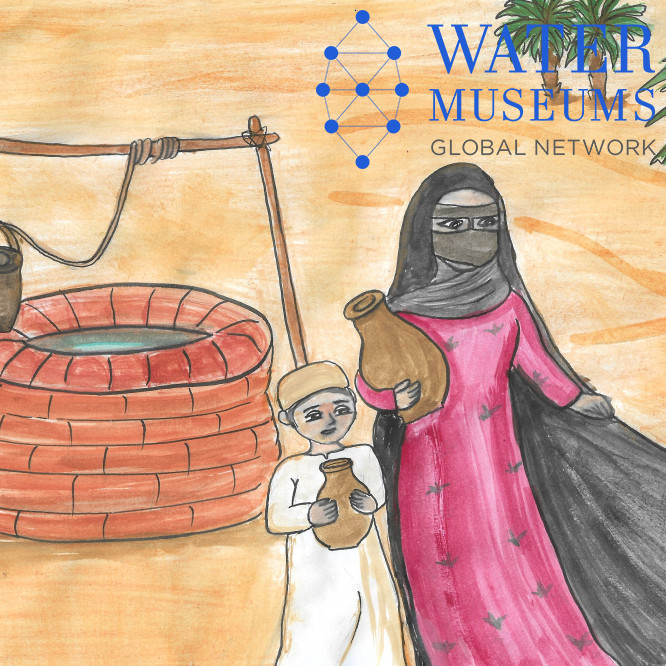
Identifier: #243
Qatar
Kahramaa Water Awareness Park Qatar
Water Journey In Qatar Through Time
Kahramaa Water Awareness Park Qatar-Sherborne Qatar School-Doha-Qatar-Laura Ibrahim Daher
Until the mid 20th century the city of Doha was almost entirely reliant on water drawn from numerous shallow wells. The population of Qatar relied on wells from which freshwater was extracted, which catered to all of their water needs. Similar to other arid and desert countries, Qatar's environment is characterized by a lack of renewable freshwater resources such as rivers and lakes. A water well is an excavation or structure created in the ground by digging, driving, boring or drilling to access groundwater in underground aquifers. Over time, the quality of the groundwater has been deteriorating, because as the fresh water is taken out, the seawater is pulled in from underground to fill the gap. So how can groundwater in Qatar be sustainably managed? Kahramaa is actively rehabilitating and activating over 300 existing recharge wells around Qatar, to increase the direct recharge to the aquifer system in the country from the rain and subsequently improve the groundwater condition and increase its availability for water security, while at the same time extending efforts to drill and develop about 60 recharge/injection and observation wells to increase the direct recharge to storage zone and to increase the productivity of the aquifer system from the rain
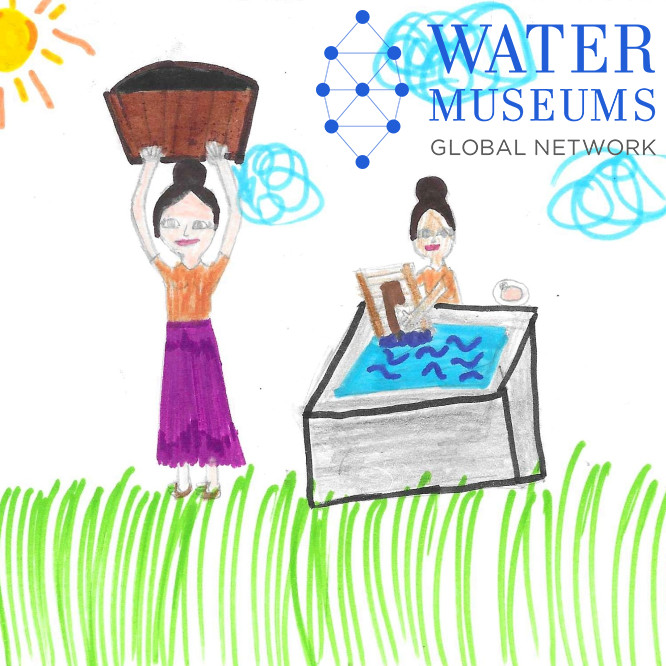
Identifier: #242
Portugal
Water Museum Parque Patrimonial das Águas
As lavadeiras (The Portuguese Washerwomen) 2
Water Museum Parque Patrimonial das Águas, Portugal. Colégio Primeiros Passos, Porto. 4th grade
The Lavadeiras (Washerwomen) are a traditional figure in the cultural heritage of water in Portugal and Porto. Washing clothes was a task reserved for women and in the twentieth century a typology of building was created for this function: the lavadouro (washing house), a communal tank where women gathered to wash clothes and socialize. The lavadouro was created not only to reduce the pollution of the city's waters, because before the lavadouro, clothes were washed in rivers and public fountains, but also to dignify the role of the Lavadeiras. This drawing was the result of a Heritage Education action with primary school children in collaboration with the master's degree in Art History, Heritage and Visual Culture of the Faculty of Arts and Humanities of the University of Porto. We believe that, based on the history of water's cultural heritage, we have been able to sensitize for sustainable practices
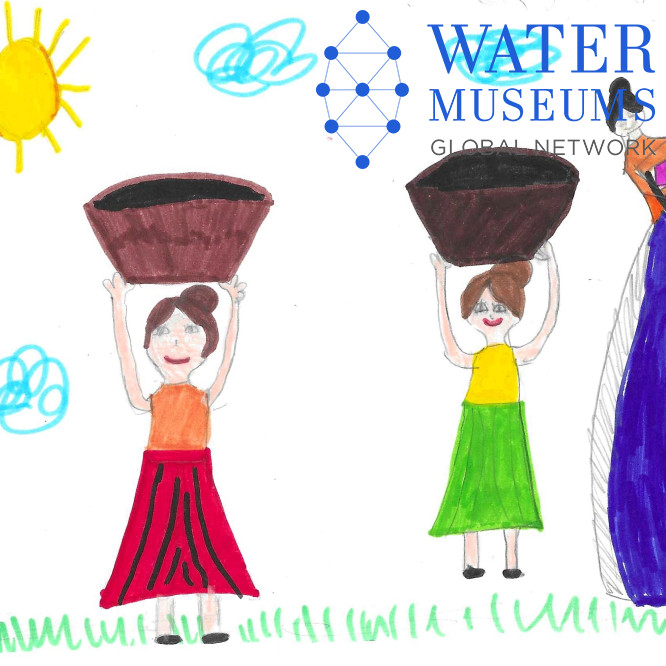
Identifier: #241
Portugal
Water Museum Parque Patrimonial das Águas
As lavadeiras (The Portuguese Washerwomen) 1
Water Museum Parque Patrimonial das Águas, Portugal. Colégio Primeiros Passos, Porto. 3rd grade
"The Lavadeiras (Washerwomen) are a traditional figure in the cultural heritage of water in Portugal and Porto. Washing clothes was a task reserved for women and in the twentieth century a typology of building was created for this function: the lavadouro (washing house), a communal tank where women gathered to wash clothes and socialize. The lavadouro was created not only to reduce the pollution of the city's waters, because before the lavadouro, clothes were washed in rivers and public fountains, but also to dignify the role of the Lavadeiras. This drawing was the result of a Heritage Education action with primary school children in collaboration with the master's degree in Art History, Heritage and Visual Culture of the Faculty of Arts and Humanities of
the University of Porto. We believe that, based on the history of water's cultural heritage, we have been
able to sensitize for sustainable practices"
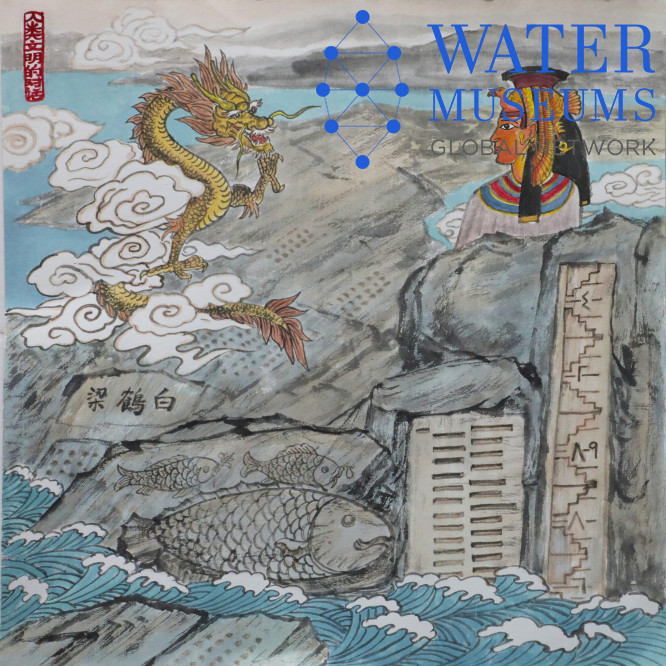
Identifier: #240
China
Baiheliang Underwater Museum, Chongqing
Dialogue of Human Civilization
Chongqing baiheliang underwater museum, China. Fuling No.14 Middle School in Chongqing. Ren Yicheng
…The Yangtze River in China and the Nile River in Egypt, both of which have nurtured ancient agricultural civilization. There are many similarities between the Baiheliang in China and the Nile Rluer in Egypt, both of which embody the great wisdom of ancient laboring people and are common wealth of human society. Jointly applying for World Heritage can better promote mutual understanding and cultural understanding among human civilizations, and promote the development of human society.
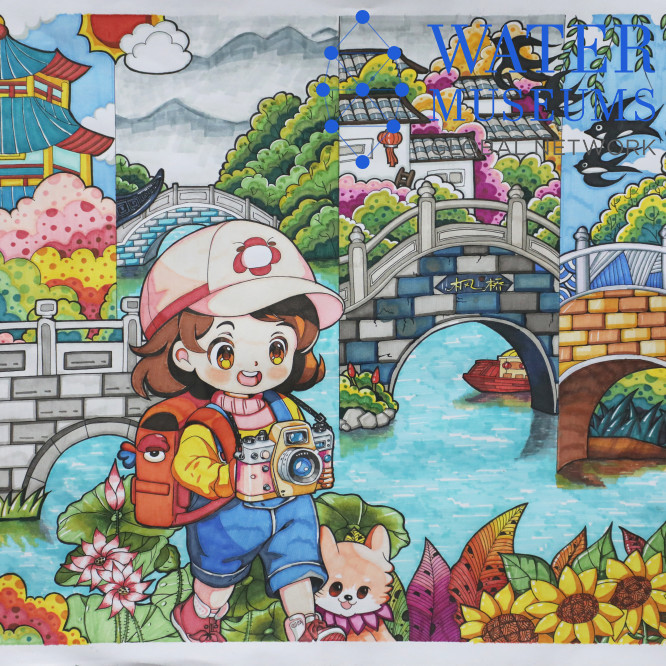
Identifier: #239
China
Baiheliang Underwater Museum, Chongqing
I Am In Jiangnan, Looking At The Waterside
Chongqing baiheliang underwater museum, China. Jiang dong liangtang primary school fuling chongqing. Chen yi Zhou
I set foot on the dream of Jiangnan, to explore the bridge flowing water people's quiet and poetic. Here, ancient houses are built on the water, and each landscape is picturesque. I saw the Hanshan Temple River outside Suzhou, the fishing fire in the river maple, the thousand-year-old temple in sorrow sleep, the beautiful legend of name of a person and Madame White Snake in the bridge breaking under the setting light of Lei Feng on the West Lake. See the canal on both sides of the ancient town of Wuzhen thick brick a tile, a water a bridge... I carry the love and attachment to this land forward, every time back to the capital can see that piece of intoxicating Jiangnan scenery
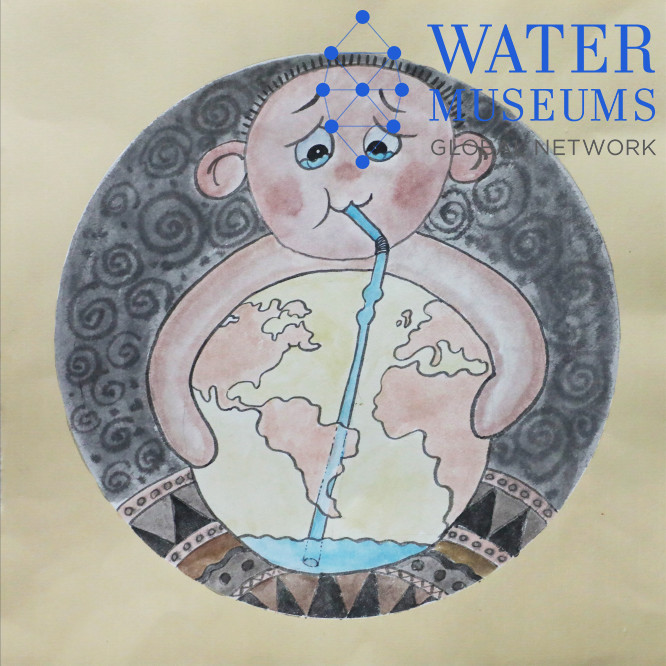
Identifier: #238
China
Baiheliang Underwater Museum, Chongqing
Water to be Drink over Soon
Chongqing baiheliang underwater museum, China. Congling Nine Year School in Baisheng Town, Fuling District,Chongqing, Xin Ling Zhou
With the development of industry, the rampant destruction of the environment by human production and life, and our waste of water resources, the freshwater resources available for our use are becoming increasingly scarce! For the reproduction of human society, we must protect our enduring freshwater resources and not let our tears of regret become the last water!
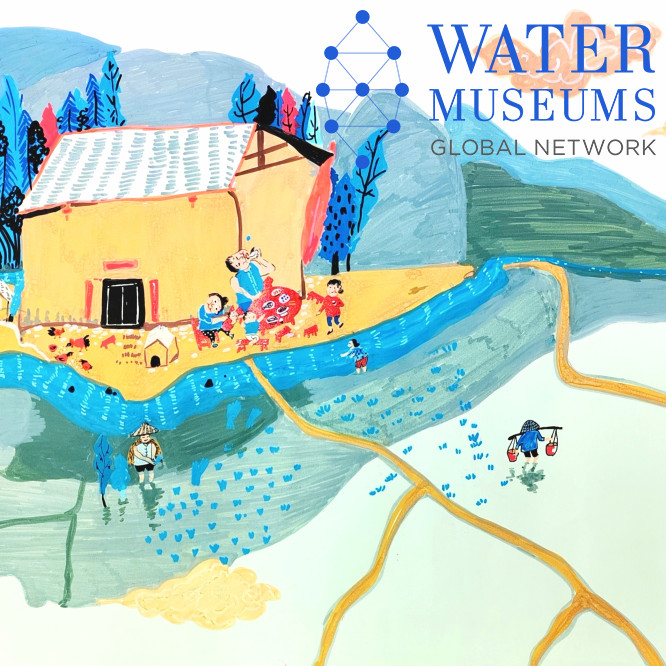
Identifier: #237
China
Baiheliang Underwater Museum, Chongqing
Grandmother’s Home
Chongqing baiheliang underwater museum, China. Zhejiang province and Fuling district friends school, Fuling Chongqing China. Jing Lin
See grandmother was seedlings in the field, this scene is picturesque
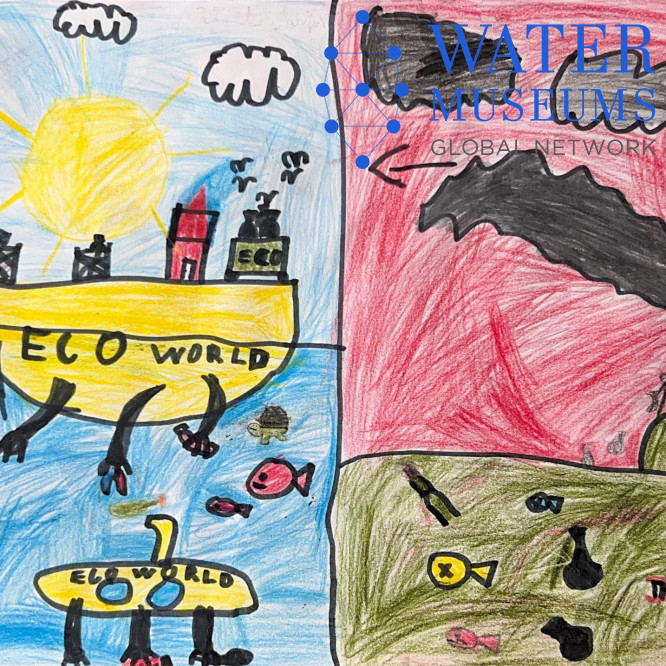
Identifier: #236
Romania
Water Museum "Leonida Truță"
A Better Environment
Water Museum "Leonida Truță", Romania. Școala Gimnazială Panda, Cluj Napoca. Chifor Victor
In my drawing I created two worlds, the bad one and the good one. The bad one shows us what it would happen, if we don't take care to not pollute the aquatic environments in which the marine creatures live. The good one, reflects one of the many solutions through which we can clean the seas and the oceans to produce our aquatic animals and to have access to clean water, which doesn't make us sick
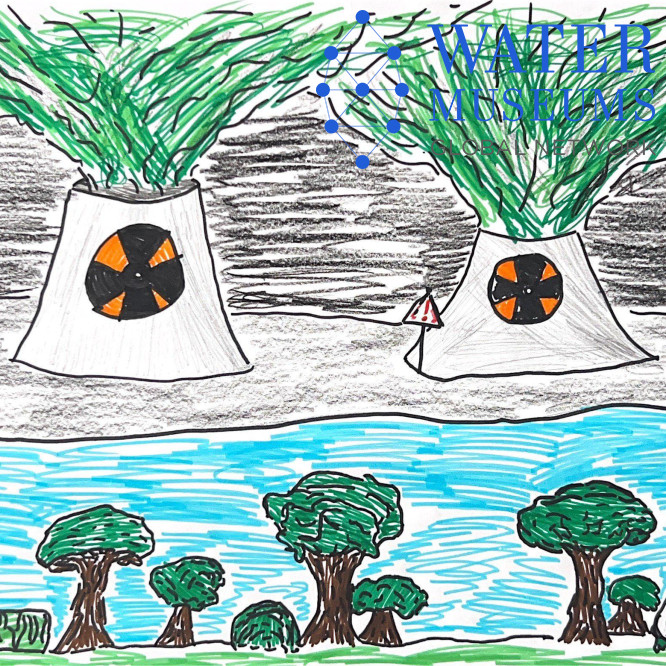
Identifier: #235
Romania
Water Museum "Leonida Truță"
How We Save The World
Water Museum "Leonida Truță", Romania. Școala Gimnazială Panda, Cluj Napoca. Stoica Razvan
In my drawing I represented the way the water saves our world. If we don't have water, both te world and the nature will suffer. The work represents a warning so save the planet by cleaning the water!
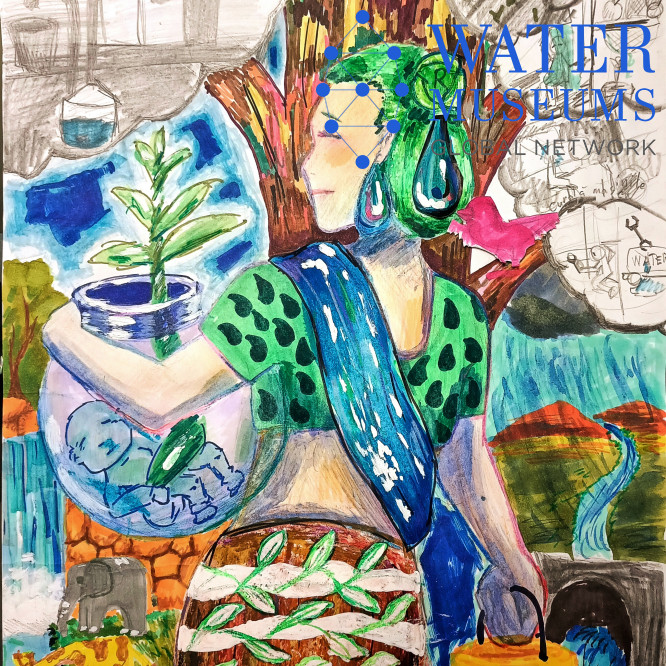
Identifier: #234
Romania
Water Museum "Leonida Truță"
I Am The Soul Of The Earth
Water Museum "Leonida Truță", Romania. Colegiul Naţional Gheorghe Şincai,Cluj-Napoca. Teachasirithavorn Sofia Ai Ming
You can read me from the right to the left, in Romanian I remain the same APA (water). I am universal from the depths of the earth to the air of haven and womb of the mother to the tears of the children. Japanese researchers have shown the world that I have memory, that I feel the people's thoughts. I feel that you can keep me delicate to protect my metamorphoses and you to be well
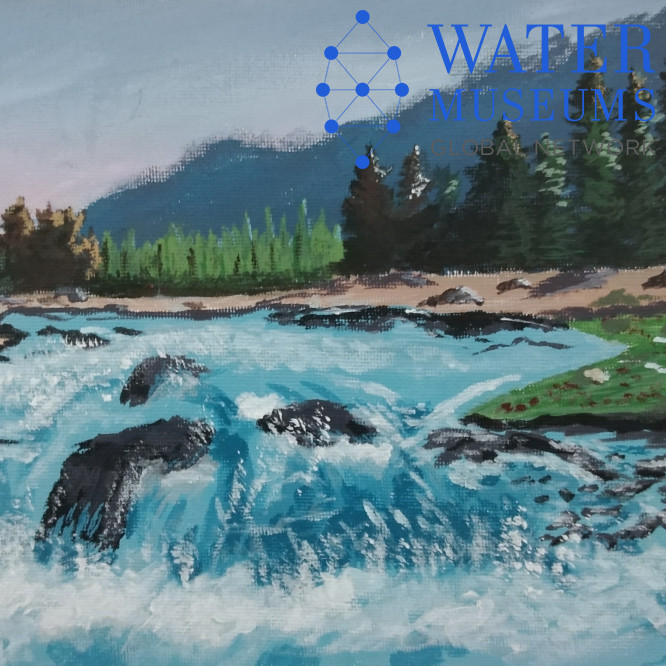
Identifier: #232
Romania
Water Museum "Leonida Truță"
The Waterfall of Pure Dreams
Water Museum "Leonida Truță", Romania. Collegiul Emil Negrutiu, Turda. Boca Hadasa Ildiko
Work done on the occasion of World Water Day 2024. It shows a breeze of water of a mountain river in a wide, wild valley, where, in the second plane you can see the coniferous forests
Identifier: #231
Italy
Autonomous Province of Trento
Parallel Worlds
Autonomous Province of Trento, Italy. Istituto comprensivo Trento 7. Daniele Bortolotti, Giona Tamanini
This drawing depicts two parallel worlds: in one world people are wasting water, while in the other one people have no water at all
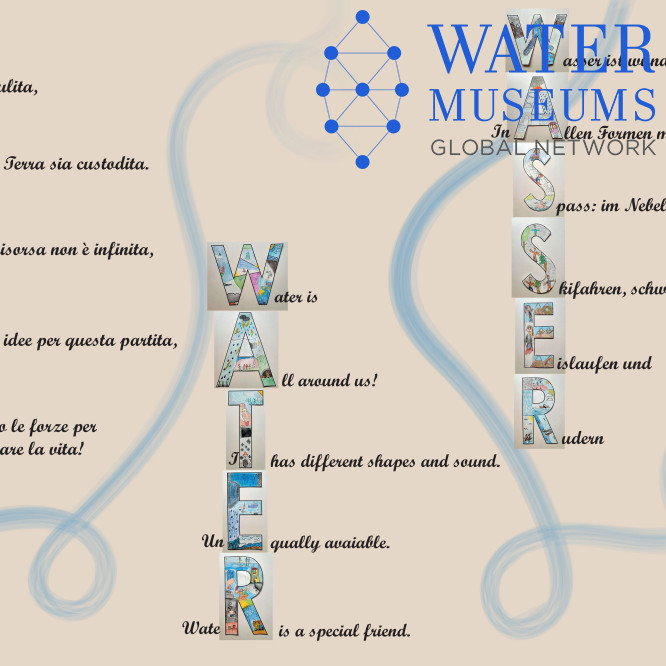
Identifier: #230
Italy
MUSE - Science Museum, Trento
Water! Acqua! Wasser!
MUSE, Italy. Scuola primaria di Zivignago. 3rd grade
After reflecting on water in it's various aspects, the third the great class decided the two include in their project an aspect important to us the languages they are learning for this reason the children created acrostics of the word water in the street different languages studied at school italian German and english several reflections emerged from this Activity during italian lessons the importance of coming together to protect this precious resource was discussed implementing a series of behaviours and measures aimed at it's preservation. During English lessons the children instead reflected on the different forms that water can take and the sound it produces. They also noticed how water is abundantly present in every living element and how it surrounds us all, even if not immediately available to everyone. Finally, with the German teacher, the theme of play was addressed: in its various forms, it allows us to discover ourselves, for example through sports such as skiing, swimming or skating. The children created three acrostics, incorporating small themed drawings inside the letters that make up the word "water" in three different languages
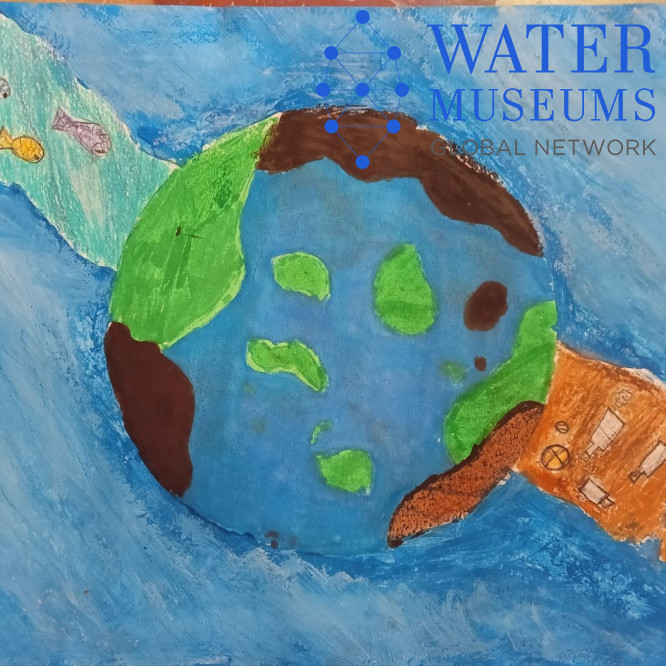
Identifier: #229
Italy
MUSE - Science Museum, Trento
The Impact Of Man On The World
MUSE, Italy. Scuola Priamria Di Albiano, Civezzano. Fourth Grade
We have represented a clear river, with fish. This river meets the earth: here it gets dirty with plastic, rubbish and pollution. The river changes color, turns brown, and there are no more fish. The idea we want to convey is that the world is polluted by humans.
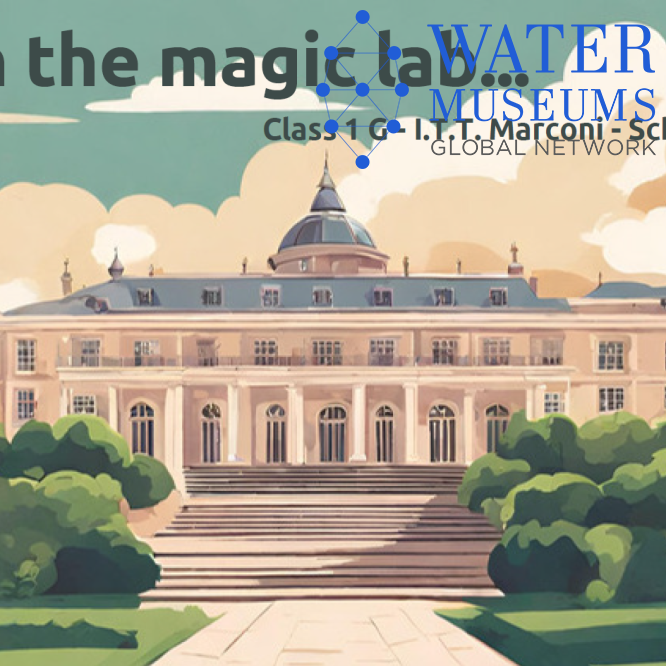
Identifier: #228
Italy
MUSE - Science Museum, Trento
In The Magic Lab...
MUSE, Italy. Istituto Tecnologico Guglielmo Marconi, Rovereto. 1g
Water is an element that can't be taken for granted. It's not an infinite resource and its scarcity on earth demonstrates how important this resource is and how essential it is to manage it in a responsible way. Assuming that all 8 billion of us need water to stay alive how to avoid wasting it and how to develop an awareness of its value starting in schools and more precisely in an amazing chemistry lab the comic book is our small but significant contribution to the achievement of environmental sustainability and to the development of a greater sense of responsibility for the life of each person enjoy the reading
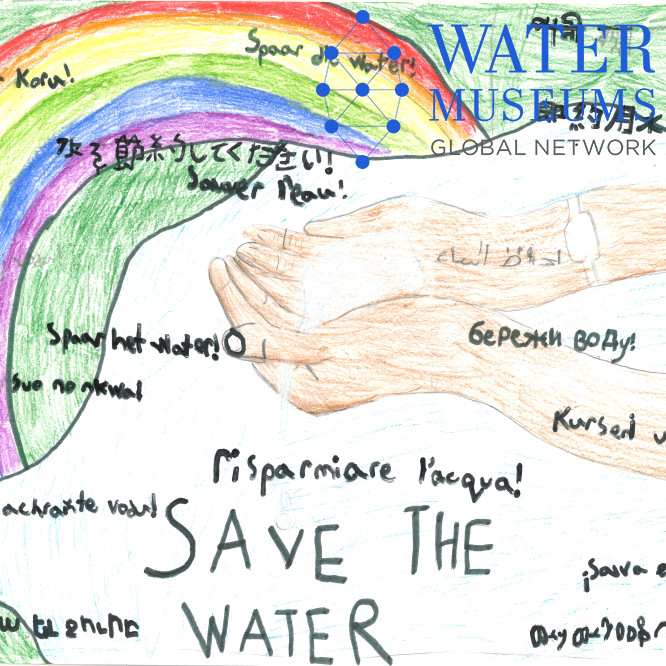
Identifier: #227
Canada
Canadian Museum of Water
Save The Water
Canadian Museum Of Water, Canada. Mundy's Bay Elementary School, Ontario. Lucy Travers
"Save the Water" by Lucy Travers (age 9) depicts a rainbow, hands, and "Save the Water" written in fourteen world languages, emphasizing the global nature of water conservation, and how solutions must be multilateral. The image depicts lean water as well as green background and a green tree, showing the correlations between water and ecology
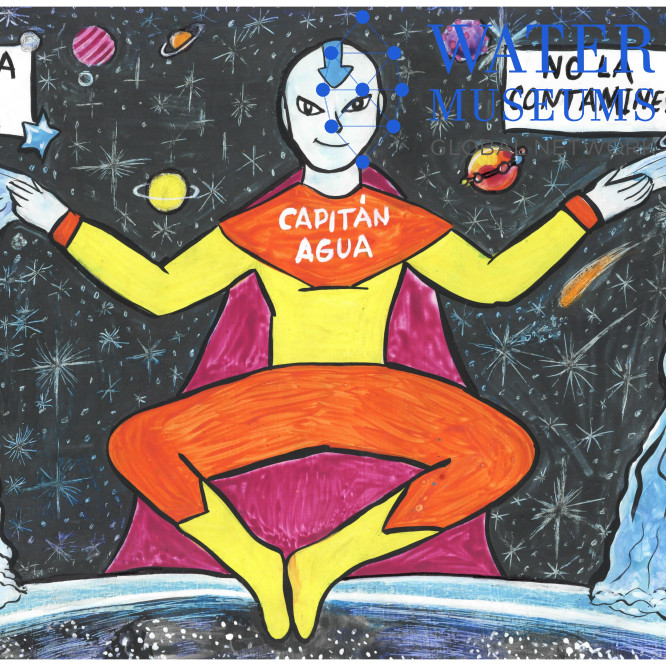
Identifier: #226
Cuba
Albear Aqueduct Museum / National Institute of Hydraulic Resources (IRNH)
Captain Water
Albear Aqueduct Cuba. Escuela Primaria Jesus Rabé Sabón, Jiguaní, Granma. Diuber Alejandro Massague Espinosa
In this work Captain Water is represented giving the message of care and saving our precious liquid. And so, when children see this great superhero, they identify with him and it motivates them to take care of water more diligently
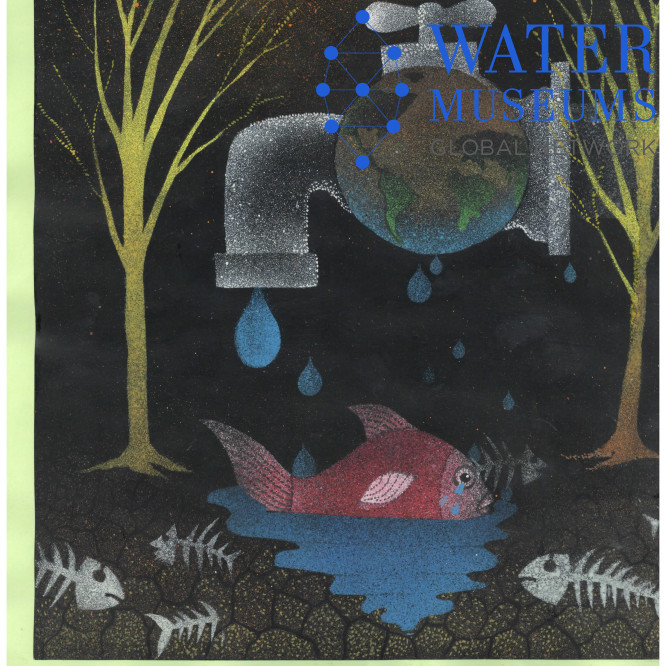
Identifier: #224
Cuba
Albear Aqueduct Museum / National Institute of Hydraulic Resources (IRNH)
Lifeless
Albear Aqueduct, Cuba. Escuela Secundaria Básica Raúl Cepero Bonilla, Frank País, Holguín. Samuel Rueda García
With the sgraffito technique, a scene depopulated by animals and nature is represented as a consequence of humans' neglect of water, where dark colors are used to emphasize the idea of desertification of the planet due to the lack of the most precious liquid in the world planet Earth.
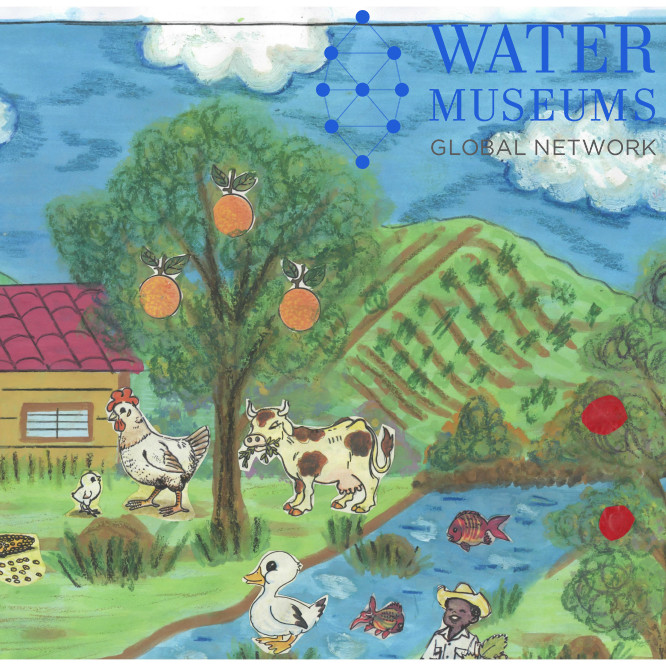
Identifier: #223
Cuba
Albear Aqueduct Museum / National Institute of Hydraulic Resources (IRNH)
Water,source Of Life And Well-being
Albear Aqueduct Cuba. Regional School for Physical-Motor Disability “Marta Abreu”, Villa Clara. Javier Pérez Rodríguez
The plastic work is made by a child with a physical-motor disability. In the work, the guide as a source of life stands out as a fundamental theme. The love and care for the fields of Cuba and nature are reflected. A landscape is identified that exposes in its maximum splendor children caring for the animals and crops that serve as food in the cycle of life. Various colors are used, highlighting green in its meaning of hope. Different materials were used such as crayons, tempera, colored collage paper. As a fundamental message, it transmits to us the love of nature from an early age and the role that must be played in the care and preservation of water and the environment
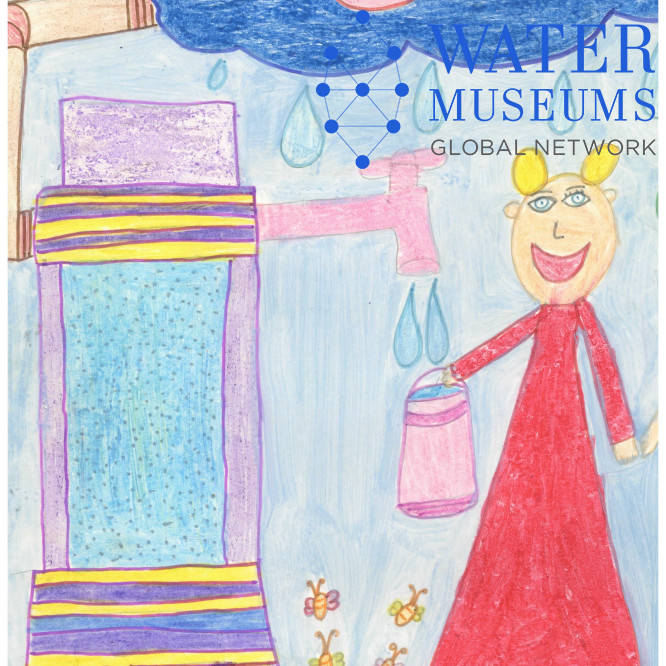
Identifier: #222
Cuba
Albear Aqueduct Museum / National Institute of Hydraulic Resources (IRNH)
Water Reuse
Albear Aqueduct, Cuba. Escuela Primaria Máximo Gómez Báez, Versalles, Matanzas. Alexa Trimiño Dregue
With the drawing the girl wanted to graphically explain how drinking water from rainfall can be reused, so that it is filtered and can be used in different activities of daily life. Using this collected rainwater for household chores is a way to save money and be environmentally friendly.
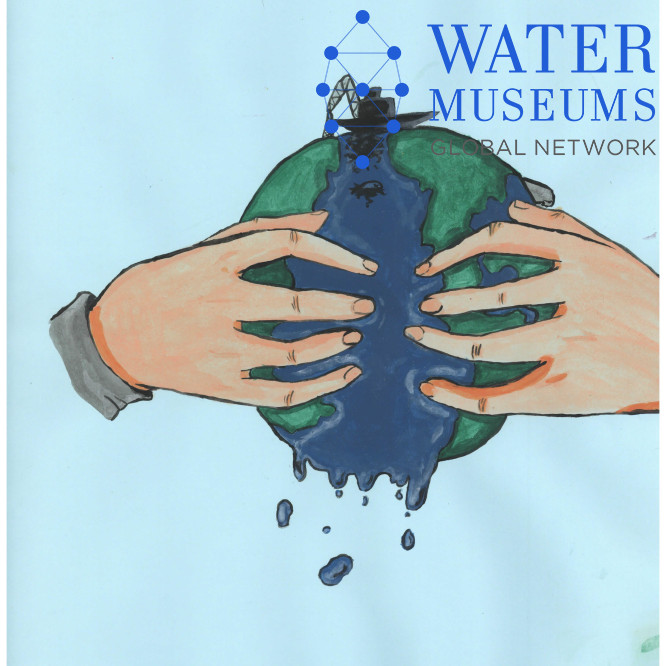
Identifier: #221
Cuba
Albear Aqueduct Museum / National Institute of Hydraulic Resources (IRNH)
The Global Spill
Albear Aqueduct, Cuba. Centro Mixto Baclin Surgidero de Batabanó, Mayabeque. Daynelis Cordero Palenzuela
In this drawing, the Earth is represented as a living being in distress. Two hands grab it and squeeze it, causing a blue liquid to spill from its surface. Hands symbolize human activity and its impact on the planet. The liquid represents the natural resources that we are depleting and the pollution we generate. The small oil platform on top of the Earth suggests a connection to fossil fuel exploitation. In short, the drawing conveys a message about the need to take care of our global home and avoid irresponsible waste
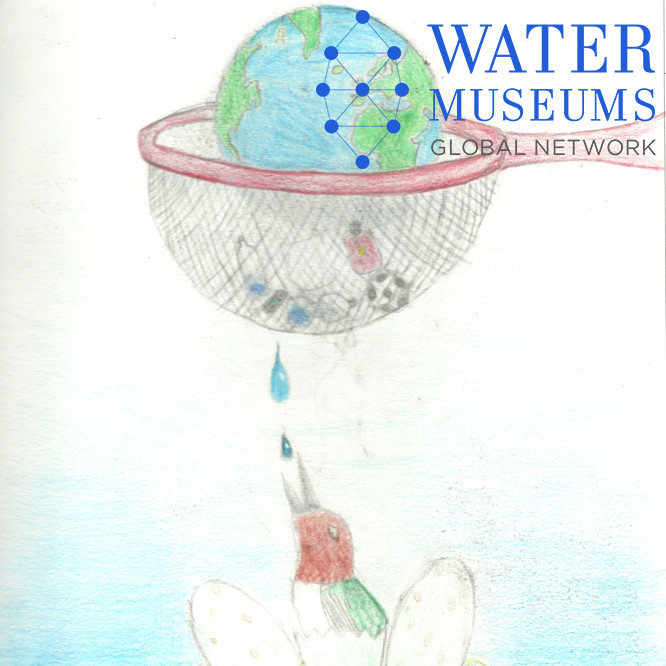
Identifier: #220
Spain
Museos de Mequinenza
Who Doesn't Fit Doesn't Fly
Museos de Mequinenza, Spain. IES Joaquín Torres, Mequinenza. Pau López
The work expresses a problem in our society, the lack of potable water as a resource for our survival, the awareness of scarcity in many areas of the planet, and the misuse and contamination of potable water. The elements of the illustration are everyday objects, alluding to the fact that small human actions are capable of moving the world.
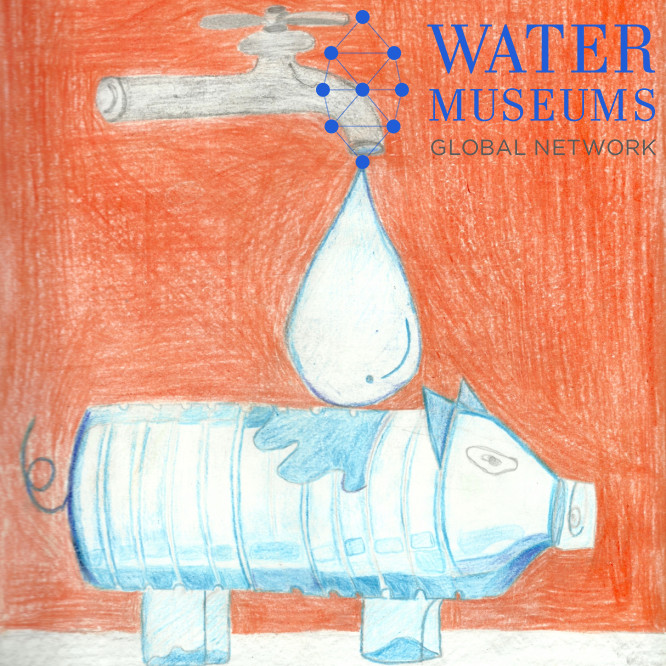
Identifier: #219
Spain
Museos de Mequinenza
Drops Of Sweetness
Museos de Mequinenza, Spain. IES Joaquín Torres, Mequinenza. Khalid Chali
Water is essential for our existence, both physically and spiritually. It nourishes us, hydrates us, and sustains life on Earth. Beyond its biological function, water connects us with nature, reminding us of our interdependence with the world around us. Its fluidity teaches us the importance of adapting and flowing life’s changes. Water is much more than a resource: it is a symbol of life, renewal and connection with our environment
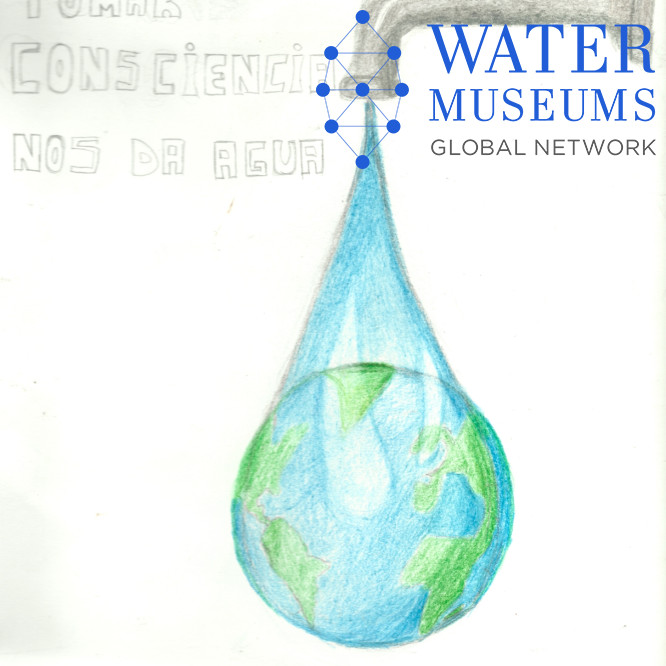
Identifier: #218
Spain
Museos de Mequinenza
Whoever Doses Does Not Sacrifice
Museos de Mequinenza, Spain. IES Joaquín Torres, Mequinenza. Aaron Esteve
This work is titled “Whoever doses does not sacrifice” to imply that there is a big problem in our society, no awareness of the scarcity of drinking water in most parts of the planet. It is necessary since water is essential in the life of all living beings. I have decided to draw since nowadays we see more of image than text. It represents everyday life on planet Earth and it is supported by a crystalline drop of water, because water and other elements are what make life on our planet possible.
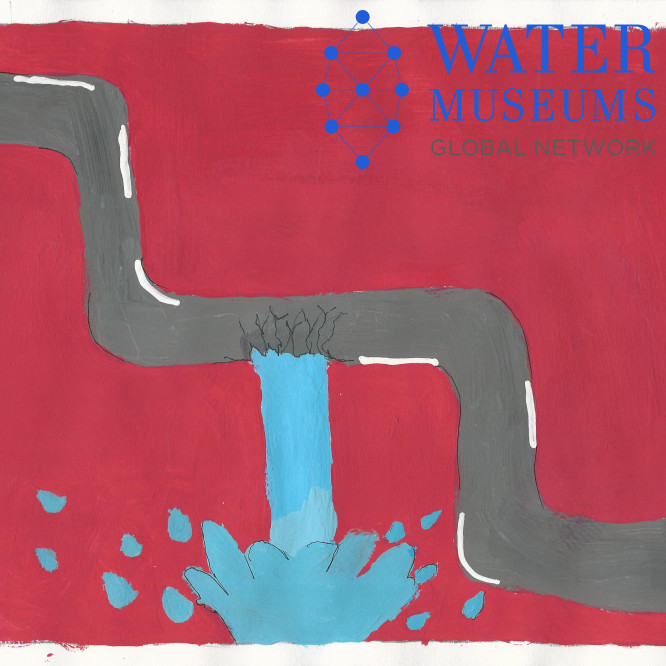
Identifier: #217
Italy
Paesi dell'Acqua
Let's Stop The Hemorrage Of Resources
Il Paese Dell’acqua, Italy. Istituto Comprensivo Nicolasole, Senise. Uccelli Melania
Freshwater is one of the most precious resources on our planet. It represents only 2.5% of the total water on Earth, but it is essential for the survival of all forms of life. Freshwater is at the base of every terrestrial ecosystem, from small mountain streams to large rivers that flow into the oceans. It is indispensable for agriculture, industry, and daily domestic use. However, freshwater is a limited resource and is increasingly under pressure due to climate change and overuse. Its importance cannot be underestimated. We must commit to conserving and sustainably managing this vital resource, to ensure a sustainable future for all living beings on Earth. Always remember, every drop counts.
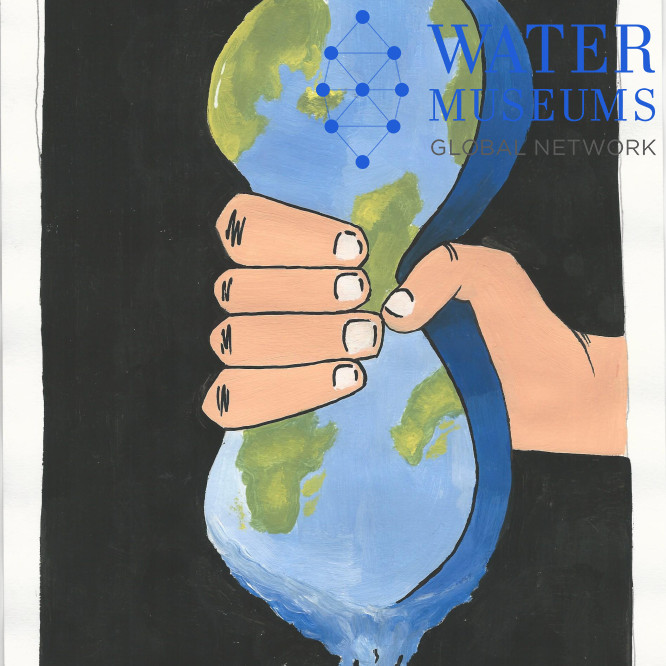
Identifier: #216
Italy
Paesi dell'Acqua
Earth, a Sponge Without Water
Il Paese Dell’acqua, Italy. Istituto Comprensivo Nicolasole, Senise. Ricciardi Domenico
Freshwater is one of the most precious resources on our planet. It represents only 2.5% of the total water on Earth, but it is essential for the survival of all forms of life. Freshwater is at the base of every terrestrial ecosystem, from small mountain streams to large rivers that flow into the oceans. It is indispensable for agriculture, industry, and daily domestic use. However, freshwater is a limited resource and is increasingly under pressure due to climate change and overuse. Its importance cannot be underestimated. We must commit to conserving and sustainably managing this vital resource, to ensure a sustainable future for all living beings on Earth. Always remember, every drop counts.
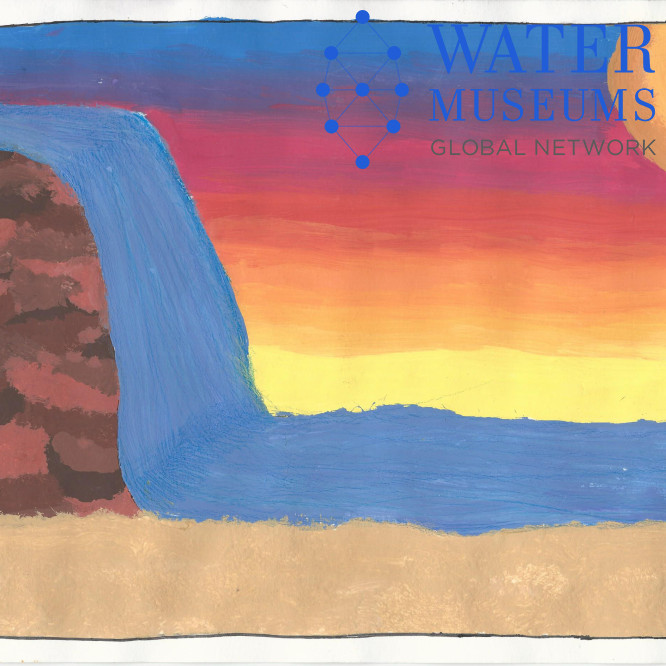
Identifier: #215
Italy
Paesi dell'Acqua
Water Is Beautyful, Water is Life, Respect It!
Il Paese Dell’acqua, Italy. Istituto Comprensivo Nicolasole, Senise. Megbuflior Amanda
Freshwater is one of the most precious resources on our planet. It represents only 2.5% of the total water on Earth, but it is essential for the survival of all forms of life. Freshwater is at the base of every terrestrial ecosystem, from small mountain streams to large rivers that flow into the oceans. It is indispensable for agriculture, industry, and daily domestic use. However, freshwater is a limited resource and is increasingly under pressure due to climate change and overuse. Its importance cannot be underestimated. We must commit to conserving and sustainably managing this vital resource, to ensure a sustainable future for all living beings on Earth. Always remember, every drop counts.
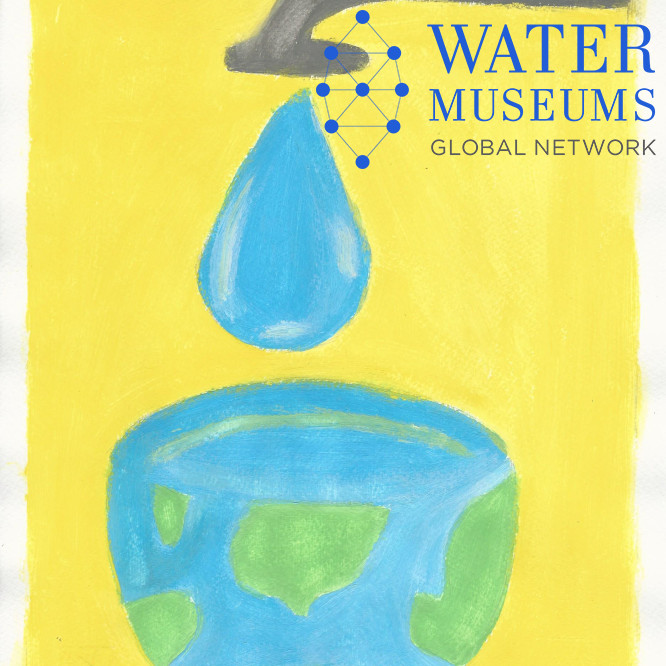
Identifier: #214
Italy
Paesi dell'Acqua
Water Makes Up The World
Il Paese Dell’acqua, Italy. Istituto Comprensivo Nicolasole, Senise. Bellusci Miriam
Freshwater is one of the most precious resources on our planet. It represents only 2.5% of the total water on Earth, but it is essential for the survival of all forms of life. Freshwater is at the base of every terrestrial ecosystem, from small mountain streams to large rivers that flow into the oceans. It is indispensable for agriculture, industry, and daily domestic use. However, freshwater is a limited resource and is increasingly under pressure due to climate change and overuse. Its importance cannot be underestimated. We must commit to conserving and sustainably managing this vital resource, to ensure a sustainable future for all living beings on Earth. Always remember, every drop counts.
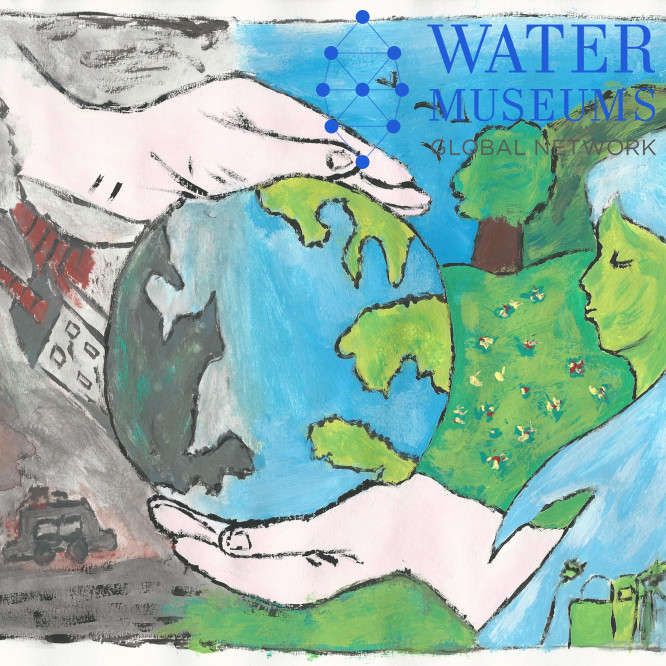
Identifier: #213
Italy
Paesi dell'Acqua
Making Sure That Water Regenerates Life Is Our Absolute Priority
Il Paese Dell’acqua, Italy. Istituto Comprensivo Nicolasole, Senise. Alvino Emanuela
Freshwater is one of the most precious resources on our planet. It represents only 2.5% of the total water on Earth, but it is essential for the survival of all forms of life. Freshwater is at the base of every terrestrial ecosystem, from small mountain streams to large rivers that flow into the oceans. It is indispensable for agriculture, industry, and daily domestic use. However, freshwater is a limited resource and is increasingly under pressure due to climate change and overuse. Its importance cannot be underestimated. We must commit to conserving and sustainably managing this vital resource, to ensure a sustainable future for all living beings on Earth. Always remember, every drop counts.
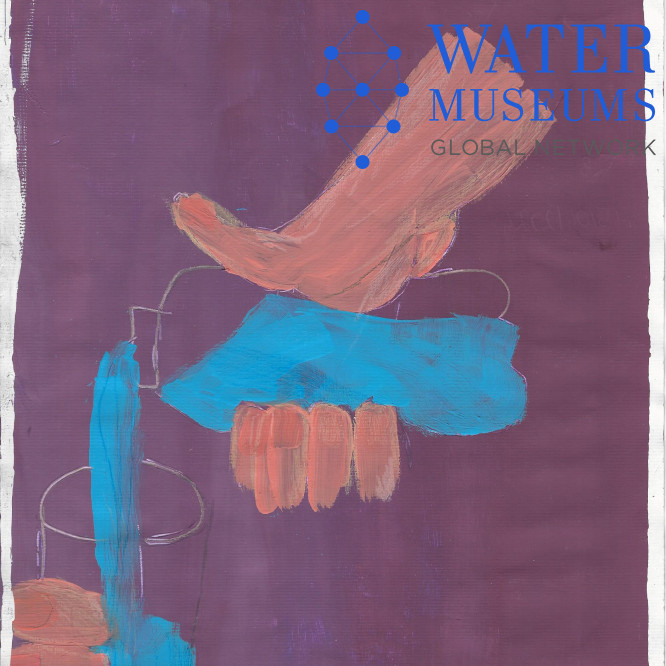
Identifier: #212
Italy
Paesi dell'Acqua
Water Is For Everyone
Il Paese Dell’acqua, Italy. Istituto Comprensivo Nicolasole, Senise. Amendolara Rosa
Freshwater is one of the most precious resources on our planet. It represents only 2.5% of the total water on Earth, but it is essential for the survival of all forms of life. Freshwater is at the base of every terrestrial ecosystem, from small mountain streamsto large rivers that flow into the oceans. It is indispensable for agriculture, industry,and daily domestic use. However, freshwater is a limited resource and is increasingly under pressure due to climate change and overuse. Its importance cannot be underestimated. We must commit to conserving and sustainably managing this vital resource, to ensure a sustainable future for all living beings on Earth. Always remember, every drop counts.
